WW1 British Destroyers
 Royal Navy (1895-1919) – About 536 ships
Royal Navy (1895-1919) – About 536 ships
WW1 British Destroyers:
26 knotters | 27 knotters | 30 knotters | 33 knotters | Turbine destroyers | River class | Cricket class | Tribal class | Beagle class | Acorn class | Acheron class Acasta class | L class | M class | Repeat M class | Medea class | Faulknor class FL Marksman class FL | Parker class FL | Talisman class | Shakespeare class FL | R class | S class | Repeat R class | V class FL | Scott class FL | V class | W class
Introduction
It is strange to think of the fact, that the largest active fleet on earth was rightly dismissive of “naval dust”. And yet had a great importance in the development of the torpedo (Via Whitehead), and its carrier, the torpedo-boat, through the first turbine ship, the Turbinia, in 1894. From there, the development of the TBD (Torpedo Boat Destroyer) was rational, logical in order to offer battleships an active protection (when anchored they had nets). The British Royal Navy was in fact one of the most innovative when researching such vessels, and Thornycroft became the worldwide reference at the end of the war and during the whole interwar as well.
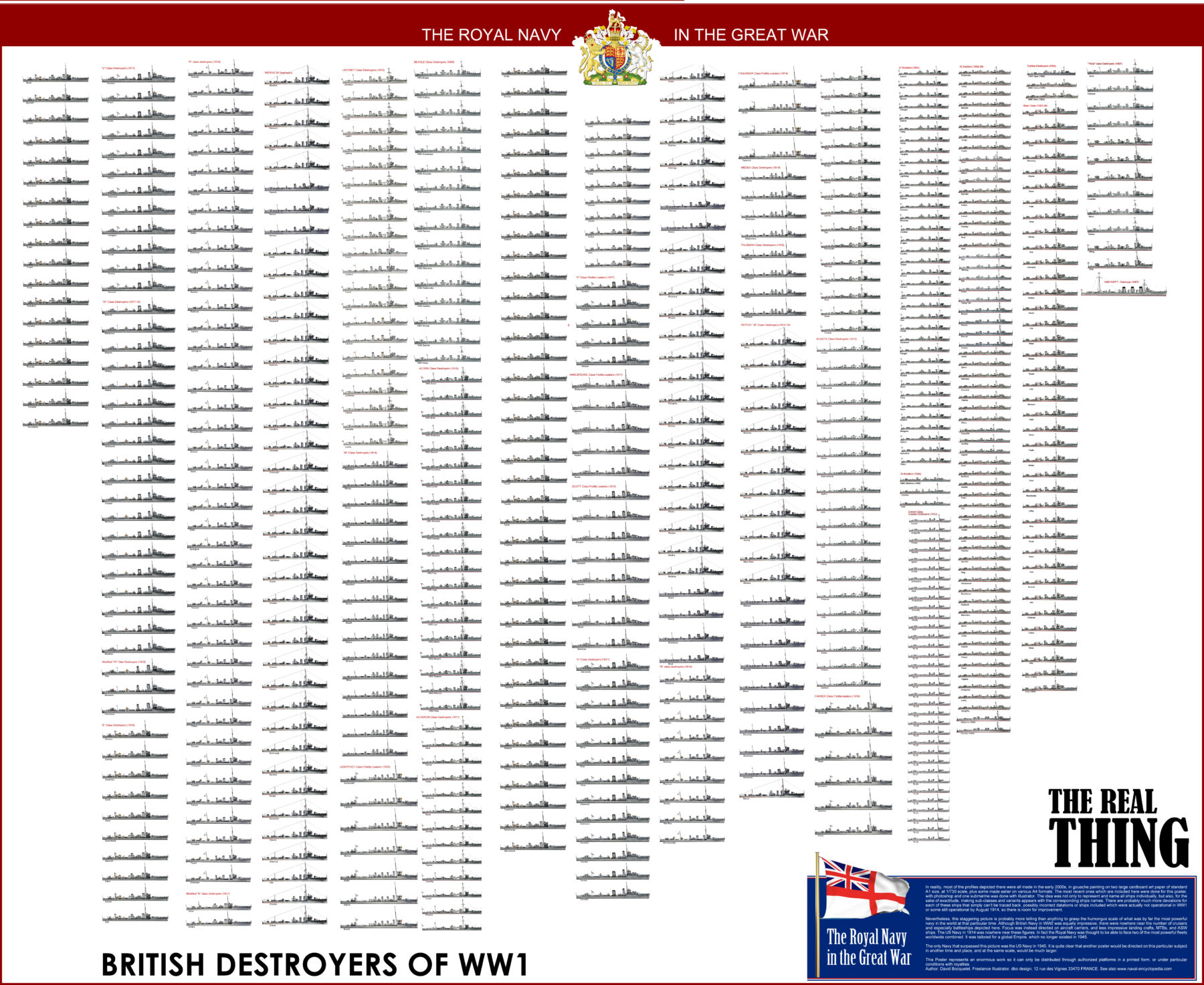
Very large high definition poster on all British WW1 destroyers.
The classic TB (Torpedo Boat) was propelled by a traditional VTE (Vertical triple engine) fed by loco boilers. Soon, the appearance of the long-range, fast torpedo obliged to see this threat not only for a fleet at anchor, but now at sea as well.
So in 1898 the concept appeared of a ship able to “catch” torpedo boats at sea, procuring escort for larger battleships and cruisers. Spanish admiral Fernando Villaamil is frequently seen as one of the earliest proponent of this type of ship. It was also soon found useful to use them as had how torpedo-boats and they were fitted with tubes. The English name “destroyer” found an equivalent in other languages, more explicit about their role, like “contre-torpilleur” in French or “cacciatorpediniere” in Italian, and also in Dutch, Polish, Czech or Greek as well.

Spanish destroyer Ariete, built by Thornycroft in 1886.
The British HMS Swift in 1907 was certainly the first modern, proper “destroyer” in the Royal Navy. This 147 tons vessel (later TB 81) was armed with two QF 47 mm guns, 23.75 knots (43.99 km/h; 27.33 mph) but with the same VTE as standard torpedo boats and almost twice their weight, they were certainly not fast enough to catch them. There were derivatives and exports as well. A good example is the Japanese Kotaka (Falcon), built in 1885 at Yarrow, Glasgow.
She was technically a high seas torpedo boat, but due to her range she was capable to escort larger ships and therefore, play the part of a destroyer, and was considered as such by the yard. Later George Thomson of Clydebank made the Destructor for the Spanish Armada in 1887, upon instructions from Villaamil, which is widely regarded as another contender for the title of “destroyer” which had the name and function whereas previous ships were just above-average high seas TBs.
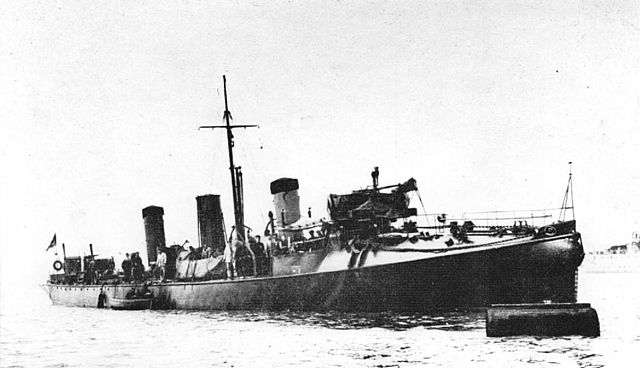
This development was slow and incremental, semi-experimental in UK until the French Young School fondness for TBs made them create the largest fleet of the kind in the 1890s, which needed an answer from the Royal Navy. In parallel existed a fad for torpedo-cruisers, small, lightweight and fast cruisers which were heavily armed to deal with torpedo-boats.
The development of proper destroyers in the 1890s made them obsolete. At that time, the concept had reach maturity within the circles of the Royal Navy, and the “torpedo boat destroyer” (TBD) was born. The HMS Havock, was its first representation, a truly modern destroyer commissioned in 1894.
Development
British developments around the torpedo (1880s)
The development of the Torpedo ((y Austro-Hungarian engineer Luppis, but perfect by Whitehead) led to several early experimentations: The HMS vesuvius (1874) was an early torpedo vessel, the first to really capitalized on the new concept. She was arguably a better torpedo boat than the Lightning, less noisy with a very deep hull and low freeboard to use the surrounding water as a shield, like for contemporary torpedo rams. She was also stealthy as there was no funnel, instead, smoke was exhausted through a serie of well-concealed vents along the hull, burning Coke to lower the level of smoke. However her slow speed meant she was only intended to sneak into harbours to led a unique torpedo attack.
In 1881 the Polyphemus was another take on the concept, this time much faster (18 knots) with four broadside tubes and one extra in the bow. But the ship was ten times larger at 2640 tons instead of 245. Her hull was also armoured and cylindrical, she almost resembled as a surface submarine.
Then came the fad of torpedo gunboats. Developed in several countries in Europe, UK, France, Italy, Austria-Hungary, Russia, the concept was an early take on the destroyer concept. In the British case, this was the Russian war scare which provoked the design of the HMS Rattlesnake (1886), the first British torpedo gunboat. She had one bow, one stern tubes and two training tubes on either beam. Three more ships (Grasshopper class) were derived in 1887, then the larger (735 tons instead of 550) Sharpshooter class, 13 ships, were built in 1889-90.
They had a better armament and more tubes. Most saw action during the war. Still close, but larger at last came the 810 ton 11 Alarm class ships (1892), armed the same but a tad slower (18.7 instead of 19 knots as designed). The Dryad class (5 ships, 1894), 1070 tons, 18.5 knots on forced heat also saw action during the war.
Early destroyers (1890s)
The Daring-class (two ships) and Havock-class (two + four exports) were good first examples of the new TBD genre in the Royal Navy and set a path to follow. However these lacked the range and speed to effectively fill their role properly. The exuberant admiral ‘Jackie’ Fisher soon emitted specifications for a new kind of TBD, setting the standards of speed and armament notably equipped with water-tube boilers and quick-firing small calibre guns. This led to the building from various yards of prototypes, HMS Daring, Decoy (Thornycroft), HMS Havock, Hornet (Yarrow), HMS Ferret, Lynx (Laird, Son & Company).
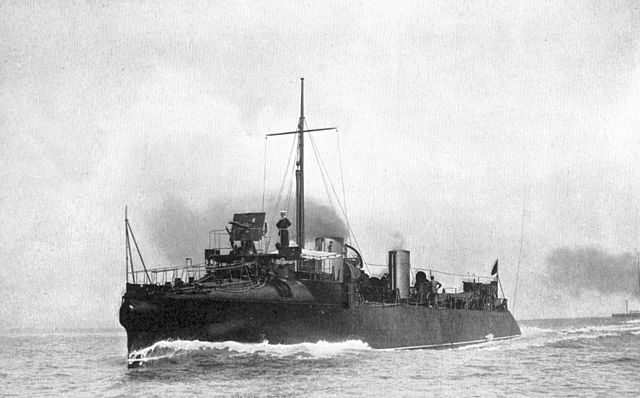
HMS Daring, 1893
They were all extensively tested at sea. At 260 tons and larger, they had indeed the range and speed to be used the right way. The standard armament was a single 12-pounder gun and three 6-pounder guns plus a fixed bow and a twin traversing tubes pair and they were capable of 27 knots. But soon, innovation was making its way in the type and the Royal Navy was the first to unveil the first turbine powered destroyer, HMS Viper in 1899. Many of these early TBs were still in service when the war broke out in August 1914, reclassified as coastal defence boats.
Other innovations: Forecastle and oil-burning
The turtleback foredeck on a raised forecastle was the first attempt to give TBDs better seaworthy qualities, especially in the high seas, vital to escort and follow the fleet by all weather. The class in 1903 counted many vessels with slight building difference (see later). But for the first time, destroyer gained this typical “toothbrush” standard look.
The other great innovation was being on the experimental HMS Spiteful, which inaugurated fuel oil propulsion. This allow to carry much more combustible in the same space, thus allowing a greater range. Plus it left a much more reduced trailing smoke, therefore more stealth at sea. In 1904, it was seen as the way forward. The USN only adopted oil-burning boilers with the Paulding class in 1909.
Post-dreadnought destroyers: Up to the ‘1000-tonners’
It was clear that the launch of a ship faster than destroyers in service, equipped with oil-fired boilers and steam turbines at that, was going to change the approach to destroyer design. In 1906 it was clear that the ‘A’ class (27-knotters) and ‘B, C, D’ classes (30 knotters) were still essentially coastal predators in nature. They were much faster than pre-dreadnought but range was limited. The ’33 knotters’ were judged unsuccessful overall. What was missing was the right machinery for the job.
The turbine destroyers
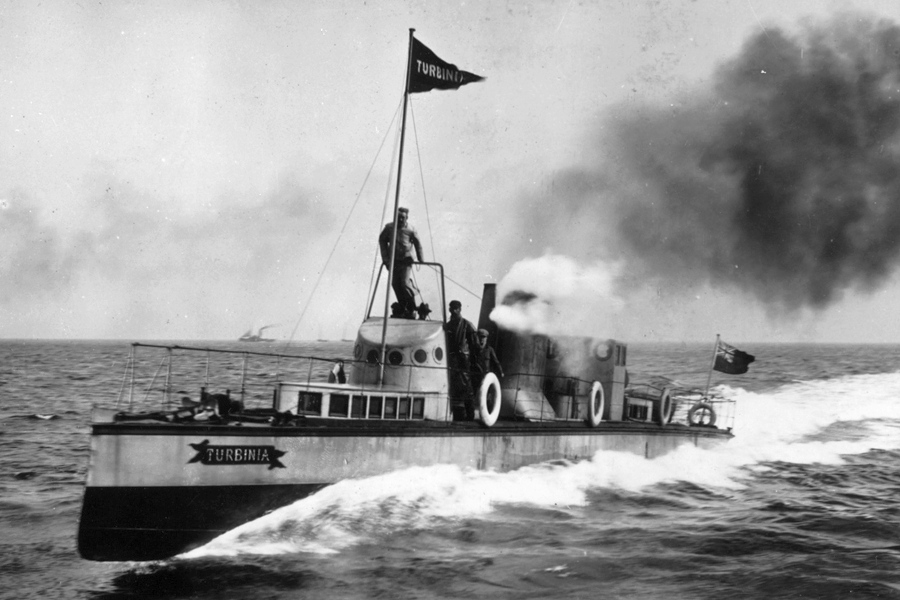
The 1897 Parson’s Turbinia bring out the response, showcasing brilliantly the concept at Spithead. Therefore, the director of naval construction, which followed its trials since a while, ordered two destroyer from Parsons in 4.3.1898 on specifications. Made at Armstrong Elswick, the 344 tons HMS Viper was launched in September while the 375 tons Cobra was launched in June of 1899. Their initial trials were successful but both were lost quite quickly, Viper stranded in Channel islands in 1901 and Cobra foundered the same year. Both had been commissioned barely a year prior.
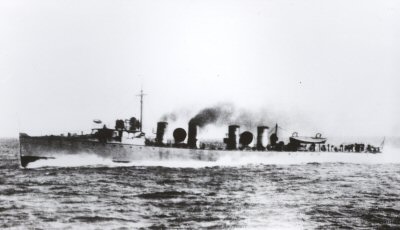
One was three-funneled, 210 x 21 feets (64.10 x 6.40 m), and possessed four shaft turbines able to bring them to 33-3/4 knots. They were carefully modelled on the 30-knotters though, armament wise, with one 12-in and five 6-pdr guns and two 18-in TTs. The four-funnelled Cobra was longer but narrower, at 213 x 20 feets (65.11 x 6.25 m) and not able to reach more than 30 knots. She suffered a collision in trials. Just like the Turbinia and Viper, the high torque of the turbines allow to mate three propellers to each shaft, therefore twelve in all.
But this only marginally improved performances so the concept was dropped. Her hull was made light than usual in destroyer construction, explaining perhaps why she broke in two and sank off the Yorkshire coast. A court martial was setup to try to explain the case, testimonies of survivors allegedly reporting a loud noise or impact before the ship broke. The commission however established it was time to inspect the strength of destroyer construction at large in the RN, looking for structural weaknesses in plans and signs of metal fatigue.
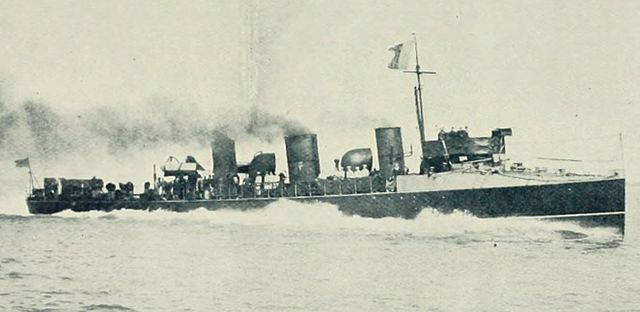
Next, Parsons started her own private-venture turbine destroyer, HMS Velox (ex-Python). She was launched in February 1902, nearly after ten month of construction, and completed in February 1904. This gap allowed to review new plans, building a 400 tons destroyer, while the hull made at Armstrong Leslie was largely strenghtened. She was 65 m long by 6 m (215 x 21 feets), but with a larger draught than the last two: 2.74 m (9 feets) instead of 2.13 (7 feets).
The great innovation was about fuel consumption: It was known that turbines were gas-guzzlers at cruise speed. They were uneconomical boats. Therefore a mixed propulsion system was installed: Two standard turbines and two TE engines for cruise. Like the previous ships she had two propellers on each of her four shafts (so eight propellers). Top speed was also reduced at 27 knots, but range was almost doubled. HMS Velox participated in WW1, mined in 1915. It should be added that an extra “River” class destroyer was orderd with turbines.
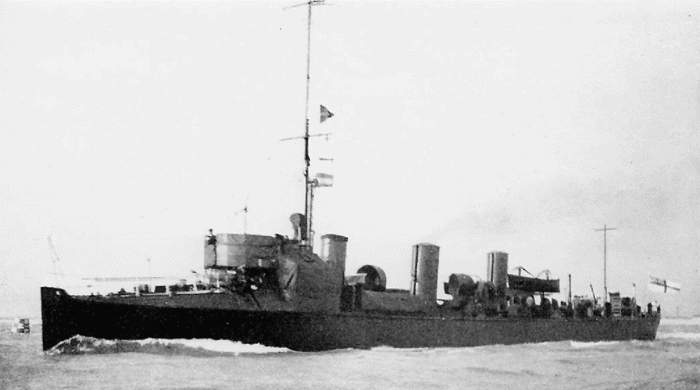
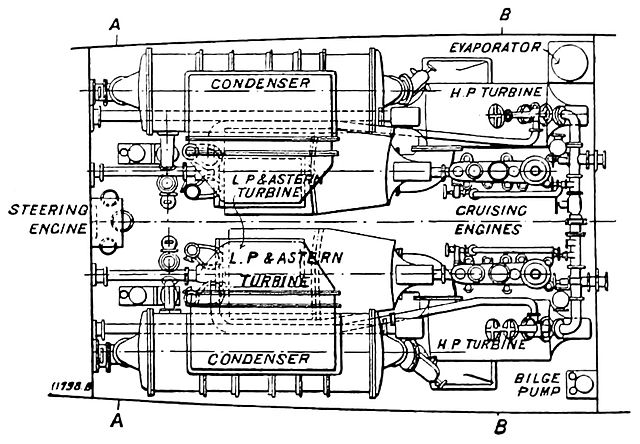
HMS Velox and powerplant
The case of HMS Swift
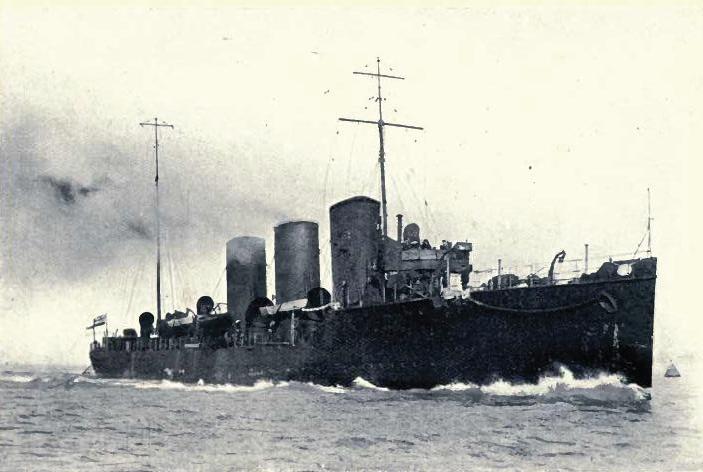
The HMS Swift, a pet project of “Jackie” Fisher, the impetuous first lord of the admiralty, was the greatest destroyer in the world, and for a long time. The concept was defined for speed, in 1905. She was to be the forerunner of a new line of fleet destroyers. He saw for this ship a derivative of the “River” class, but using turbines, oil-burning boilers, to be capable of 36 knots.
The Admiralty’s board of directors replied that it was impossible on a ship derived from the River class ship, and that a brand new design had to be developed. Finally Camell laird, after much reluctance was accepted his final design on the last project (3 were defined, and the yards had 4 weeks to make a final design on this basis) and her construction.
HMS Swift in the end had nothing to do with the “Rivers” because of tonnage and dimensions much higher to accommodate the huge machinery required. With 2300 tons fully load, she found herself cruiser size, although weakly armed.
Too ambitious, this ship was not accepted for service until February 1910, after two uninterrupted years of laborious tests and propeller changes, and the speed of 35 knots was acquired only after great efforts and sacrifices (the contract was 36, and the yard was penalized by a fine of £ 5,000 – For a total of £ 233,000.
Although very seaworthy, this ship was an oil guzzler, consuming almost thirty tons per hour at full speed. In 1912 she took the lead of the 4th squadron of destroyers. From 1914 she served in the North Sea but was massively disappointing. She underwent a short overhaul and in June 1915 and passed to the Dover Patrol as leader of the 6th Squadron.
She exchanged her 4-inches on the forecastle for a single 152 mm gun (6-in), and with the HMS Broke, took part in an action against German destroyers on April 20, 1917, where she was severely damaged. Repaired, her footbridge was enlarged and rearmed with two quick firing 102 mm mk.V guns. She was assigned to Dover until her resale to be broken up in 1921. She would remain as one of the Royal Navy’s most costly failures.
Technical specifications
-Displacement 2170t, 2390 t FL
-Dimensions: 108 x 10.4 x 3.2 m
-Propulsion: 4 shafts Parsons turbines, 12 Laird boilers, 30,000 hp. 35 knots
-Armament: 4x 102 mm, 2x 457 mm TTs.
-Crew: 79
Armaments
The first TBD (Torpedo Boat Destroyers) were understandably lighly armed, although they had at least one gun of a larger caliber than anyone found on a torpedo boat. The 1896 Yarrow 26-knotter of the Havock subclass had one 12-pdr (76 mm) and three 6-pdr (47 mm QF), but also one fixed bow tube and two axial ones on the deck aft. But from 1893 the great standard of 27 and 30, 33 knotters became one 12-pdr, five 6-pdr and two 18-in TTs. On the River class, the 6-pdr were shown too weak to be effective during the Russo-Japanese war, and four 12-pdr were fitted instead. The River were also better overall, sturdier, seaworthy seaboats, sacrificing speed, which was contracted at 25 knots.
Next came the first large fleet destroyer of the RN, the ‘Tribals’. They were not only larger but also faster, reaching 33 knots. The original ‘1000 tonners’. They were armed with two 4-in or 102 mm/45 Breech Loading Mark IV, and for some, three 12-pdr/12 cwt QF guns and the usual centerline twin 18-in TTs (457 mm). The cost of the program led the admiralty to design coastal TBDs (reclassed as Torpedo boats in 1914), the Cricket were armed with just two 12-pdr but had three TTs centerline. Late “repeat river” HMS Stour & Test built in expectation to receive ordered were armed with the old combination of one 12-pdr and five 6-pdr.
The Swift had more modern Mark VIII 4-in guns and the same axial TTs and was woefully under-armed, one 6-in being fitted during the war. The more modern Beagle class of 1909-1910 were given a single forecastle 4-in Mark VIII completed by three 12-pdr either side for the funnels and axial aft, before the TTs. For the first time the caliber, new standard reached the final 533 mm or 21-in, RGF Mark VIII with Hardcastle heater. The configuration was the same, two axial tubes, including one at the stern.
The next Acorn and following classes had in standard two 102 mm (4 in) surelevated forward and aft, and 12 pdr/12 cwt. One note for the next Acheron class (1911), the six “specials” of the Australian group were given older 18-in TTs instead. This configuration went through the Acasta (1912), but on the ‘L’ class (1913), three 4-in Mark IV were adopted, the extra one in a raised position between funnels 2 and 3. Also for the first time, the TTs were grouped in twin mounts, for four tubes total. That was a welcome increase as WW1 just broke out. The wartime series started with the ‘M’ class which replaced the previous Maxim .303 in machine gun by a more potent 2-pdr ‘pompom’, two 40 mm QF automatic guns. The next ‘repeat-M’ had just one.
This was unchanged on the ‘R’ class, modified ‘R’.
However the concept of flotilla leaders emerged, influenced by export designs. They were larger for special accmodations, more range and had one more 4-in gun. On the “Lightfoot” searly serie of 1915, the extra 4-in was stuck between funnels 1 and 2. There was the larger Faulknor class (six 4-in as designed) were finally armed by two 4.7-in completed by 4-in on either side of the bridge. The Parker class introduced a superfiring 4-in forward gun. This proved to be successful enough to be ported on the ‘V’ class flotilla leaders, later declined into a whole serie, the late ‘V-W’. Alongside, new, more powerful flotilla leaders of the Admiralty or Shakespeare class were armed by five 4.7 in guns, which introduced a new standards for the 1920s.
To deal with the larger planes of 1917-18, the 2-pdr was judged unsufficient and a 3-in 12pdr/12 cwt AA gun was fitted instead on the late war V and W classes and their repeats. TT banks were still twin at that point, however triple banks had been inaugurated by the Shakespeare class leaders, repeated on the Scott class (1917-18). The ‘S’ class ships signed a return to ecomical war production models, with just three 4-in guns and one 2-pdr and two twin banks.
The real game changer was the “W” class of 1918. These were “standards” bring up to flotilla leader size. They had four 4.7 in guns in superfiring positions, a more potent AA with one 3-in gun and two single 2-pdr guns and two triple TT banks. Although most of the order was cancelled when the war ended, these ships made the blueprints of interwar British destroyer design. It should be noted than none of these classes received deep charges, which existed at that time, nor sonars. They were used only by dedicated vessels in 1918.
Tactics
Wide subject, which of course evolved throughout the development of destroyers proper. In the 1890s, these were TBDs, torpedo boat hunters, designed to catch and kill possible torpedo boats threatening battleships. And this was at anchor, not even at sea, although this became soon self-evident. However since they were still fragile, small, with poor seaworthiness in heavy weather and low range, not ideal to say the least as fleet escorts. Torpedo gunboats were already tested in that role for a time, before being dropped, and cruisers gained this task.
With the arrival of the turbine and Admiral Sir John Fisher’s own ideas, a new generation of destroyers emerged amidst the failure of the Swift: The River class. They were sturdier, had a forecastle to get through the north sea’s heavy weather, a longer range but slower speed, barely 25-27 knots compared to 33 on previous TBDs. At last the Royal Navy not only had a destroyer able to carry out successful escorts but to follow the fleet in all situation, with a reinforced armament. This was the result of Fisher’s December 1904 directive, asking for ships able to steam at 33 knots for 8 hours, with oil burning boilers only, armed with two 12-pdr and five 3-pdr, and with stores for seven days. It was later cut down to four days. From this emerged the Tribals. Ambitious, but costly ships that were ever repeated. They were however, hard pressed during the war, taking many losses in the process. In fact, the following “M” class and prewar types were also hard-pressed and overused to such a point they became worn-out early on.
The next classes, the Beagles, Acorn, Acheron, Acasta and Laforey classes had all a reinforced armament and were more versatile than ever. They could perform their expected long range escort missions with the new Dreadnought fleet wanted by Fisher. Soon however after the war broke out, it seemed reasonable to design a ship equipped to serve as a flotilla leader. The concept was born in the Royal Navy and not in any other fleet. These were enlarged destroyers fitted with extra communication, mapping and planning facilities for officers, “command destroyers”, larger and better armed than usual. Until the end of the they will prove their worth, however the concept started to fade away in the interwar. It remained typical of these wartime years.
The flotilla commodore (who typically held the rank of captain), could count on a wireless room, senior engineering and gunnery officers, and administrative staff in support. The concept was applied early on, to the HMS Swift, and in wartime to the Faulknor, Marksman, Parker, Admiralty and Thornycroft type leaders. Other fleets would have such destroyers, like in France in the interwar, Germany with the Type 1936A, Soviet Leningrad and Tashkent classes, Italian Navigatori-class, American interwar Porter and Somers classes or the Dubrovnik and Mărăști-class. In Japan, light cruisers had that role, from the Tenryū to the Sendai classes.
Four great would showcases some tactical aspects of the use of destroyers, which at that time did not included directly ASW warfare. This aspect was left to specialized gunboats, deep charges and primitive acoustic devices being adopted in 1917-18. However During the war, the British Navy lost 67 destroyers and 3 leaders in total. This was heavy compared to many other classes, which proved the versatility and usefulness of the type. They equipped nine flotillas as well as the Home Fleet and China Station squadrons.
The first serious test came in the bay of Heligoland Bight on August 28, 1914. The G194 stumbled upon the Arethusa leading four detsroyers. In the fierce engagement that followed, one German DD and three light cruisers were sunk. But if German sailors noted the superiority of the British destroyers’ armament, they also discovered the poor quality of their shells, reducing their effectiveness.
By January 24, 1915 at the Dogger Bank, British destroyers took an important part in the outcome: The 1st and 3rd flotillas met the German battlecruisers, and soon M-class destroyers would duel against the armored cruiser Blücher. The latter was engaged by the Lion and other British capital ships but sank by British torpedoes.
On April, 25, 1916, Admiral Scheer launched a raid on Lowestoft. The goal was to provoke the British fleet into a hot pursuit, towards minefields and ambushed submersibles, the tactic that prevailed since pretty much the beginning of the war on the German side. The British sent three light cruisers and eighteen destroyers to divert the German force from the City. Facing battlecruisers, and badly hit, the Cruisers escaped under the British destroyers’s smoke screen. One day before, destroyers had been damaged while covering minelayers in action off German Navy’s Flanders U-boat flotilla based in Bruges.
During the Battle of Jutland, the British lost one leader and seven destroyers, often fighting German destroyers, among which four only were sunk. These shown severe shortcomings with the Flotilla organization and characteristics at large. Both sides made several reciprocal destroyer attacks, but only 13th British flotilla destroyers scored a torpedo hit on the SMS Seydlitz, which survived it. This was the only success for a deployment of 72 destroyers and 5 leaders from seven different flotillas on the British side.
British destroyers participated in large battles. But outside fleet formations, they became often ad hoc submarine hunters. Very efficient at that, and often by ramming German U-Boats, capitalizing on their great speed. They would claim no less than a third of the 186 submarines sunk during the war.
Read More/Src
Chesneau, Roger, ed. Conway’s all the world fighting ships 1865-1905; 1906-1921; 1922-1947
http://www.fr.naval-encyclopedia.com/1ere-guerre-mondiale/royal_navy.php#dest
Cocker, Maurice; Allan, Ian. Destroyers of the Royal Navy, 1893-1981.
Friedman, Norman (2009). British Destroyers From Earliest Days to the Second World War.
March, Edgar J. (1966). British Destroyers: A History of Development, 1892-1953
Rohwer, Jürgen (2005). Chronology of the War at Sea 1939-1945: The Naval History of World War Two
Whitley, M. J. (1988). Destroyers of World War 2.
British Destroyers: A History of Development, 1892-1953
British Destroyers: From Earliest Days to the Second World War
British Destroyers 1892-1918 Jim Crossley
Strategy and War Planning in the British Navy, 1887-1918 Shawn T. Grimes
Nomenclature of British destroyers
“27 knotters” type DDs (1894-95)

Author’s rendition of the 27 knots type (like all following profiles but indicated otherwise)
Among the oldest British destroyers in service in 1914, the survivors of the “27 Knotters” class had been painted in grey, added a Wireless radio, Lewis machine guns, and sometimes closed bridges. However their hull was typical of the classic torpedo boat style, with a continuous bridge, low and “turtleback” prow.
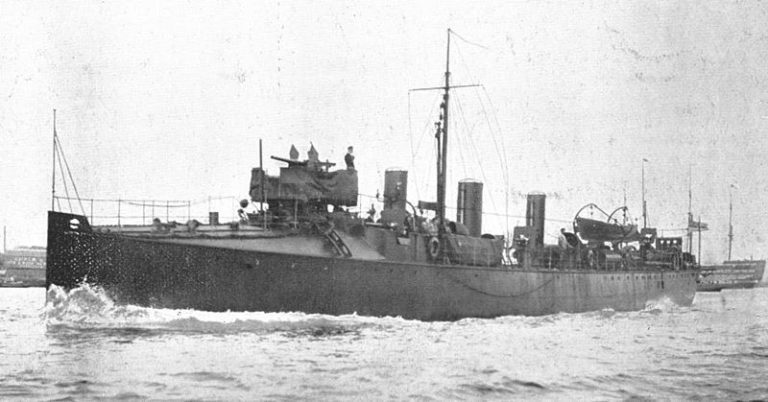
They were not therefore very seaworthy, and like the 30 and 33 knotters, served mainly in coastal squadrons during the conflict. The 27 knotters class as a whole, was ordered in 1893, originally 36 destroyers divided among 14 different shipyards. Nearly half were withdrawn from service in 1910-11. In August 1914 there were only 9 in service, enlisted but with variable status.
They differed according to their manufacturer in displacement and size, from 295 to 365 tonnes fully loaded for 61-62 meters long. Their machinery diverged, rated for 3600 to 4800 hp. Their silhouette also varied according to their Yard-based arrangements of machines and armament. As required by the admiralty they all had triple-expansion machines, with the exception of Thornycroft’s three four-cylinder Compound ships.
The only lost during the war was HMS Lightning, hitting a mine in 1915. Lighting, Porcupine and Janus were built by Palmer and considered the best of this series, the most seaworthy.
Technical specifications
Displacement: 275 t, 320 T FL
Dimensions: 62.26 x 5.94 x 2.44 m
Propulsion: 2 shaft loco steam engines, 4 boilers, 3900 hp. 27 knots
Armament 1x 76mm gun, 5x 47mm guns, 2x 457mm TTs (axis).
Crew: 63
“30 knotters” type DDs (1895-1900)

HMS Cygnet

HMS Avon

HMS Brazen
With 61 destroyers built in 5 years, this class of “30 knotters” (or later B, C, D) was by far the most valuable of the old “turtleback” series. They were low on the water, whose front beach was not yet surmounted by a farther able to the high seas. The top speed of 30 knots was moreover symbolic, as the ships diverged greatly as usual, between pierce-meale Yard orders. The admiralty asked these to be at least as fast as the French torpedo boats like the Forban. These Units were produced by 9 yards, here is the detail:
Thornycroft: Desperate, Fame, Quail, Avon, Star, Brazen, Violet, Mermaid, Osprey, Dove
Laird: Trasher, Bittern, Whiting, Electra, Sylvia, Cheerful, Fairey, Bullfinch
Vickers: Mallard, Virago, Otter, Bat, Recruit, Greyhound, Gipsy
Palmer: Angler, Earnest, Leopard, Crane, Vulture, Racehorse, Leven
Thomson: Coquette, Griffon, Vixen, Flying fish, Kestrel, Roebuck, Ostrich
Doxford: Cynthia, Locust, Flawn, Thorn, Falcon
H. Leslie: Cygnet, Panther, Flirt, Vigilant
Fairfield: Stag, Seal, Peterel
Earle: Wolf, Spiteful Orwell, Myrmidon, Lively, Syren, Sprightly, Kangaroo
Each manufacturer had its own recipes and produced dedicated series, and indeed there were only a few homogeneous series, such as the first of Thornycroft (the pioneer in four-cylinder Compound machines and efficient boilers), with 4 units, and Laird’s first, and Palmer’s with 6 each. The others were produced in sets of 3, 2, or even a single unit, and experimentation was king, but apart from Thornycroft’s ships, all the others had triple-expansion machines.
If the speed remained unchanged and 30 knots as designed, some easily passed the threshold of 30 knots in testings, while others struggled to reach desired figure, if not heating the boilers blank. In any case this speed of 30 knots was more a PR exercise in effect than a reality. With time and worn-out engines, 25 knots were rarely exceeded. It depended also on near-perfect circumstances and pristine weather. Vibrations were also caused by a too frail construction and therefore also limited the top speed that can be reached.
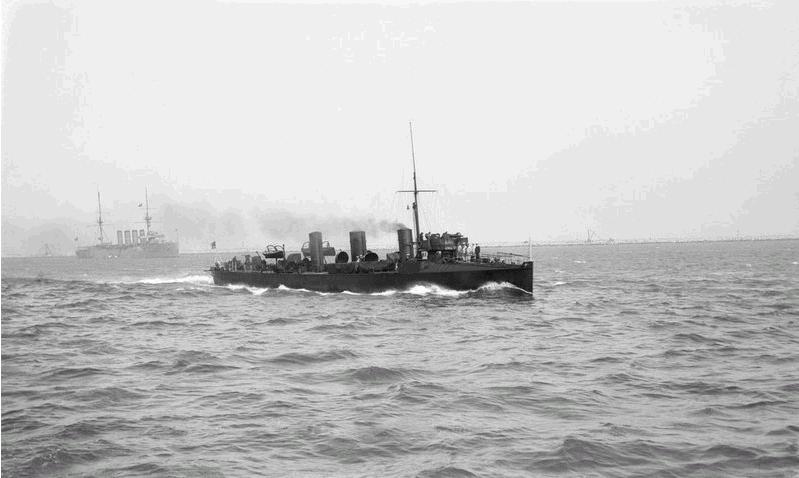
HMS Greyhound as an escort vessels in WW1
They varied in size and appearance: The first measured 64 meters, the last 67 meters. Their width ranged from 5.95 to 6.55 meters. Their tonnage also varied from 310 to 390 tons, and their armament always included one 76 mm (3-in) gun and four 47 mm (12-pdr), supplemented by two 457 mm (16-in) torpedo tubes in the axis. Their standard crew was 61 men.
Before the war, seven 30-knotters were lost or discarded for various reasons, the others were reclassified as coastal vessels, and served until 1920-21 before being discarded too. Four were lost in action: The Recruit, Cheerful, Coquette, Flirt, and three others were lost by collision and one was reformed in 1916.
Technical Specifications (Cynthia, Thornycroft)
Displacement: 335 t, 375 T FL
Dimensions: 65.7 x 6.25 x 2.26 m
Propulsion: 2 shafts, 4-Cyl. compound engine, 4 boilers, 5700 hp. 30 knots
Armament: 1x 76mm (3-in) gun, 4x 47mm (12-pdr) guns, 2x 457mm (16-in) TTs (axis).
Crew: 61
“33 knotters” type destroyers (1898-1900)
Following the arrival of the French Forban high seas, fast torpedo boat, the Admiralty ordered in 1897 plans for units capable of up to 33 knots, a speed still unprecedented for VTE steam engines. The manufacturers did not jostle so much the problems found in service with the “27 knots” and worsened with the “30 knots” (which moreover never used this speed in service) seemed to make the task impossible for engineers.
Yet the challenge was met by three projects: Thornycroft who released his HMS Albatross, Laird his HMS Express and Thomson the HMS Arab. These three ships which passed the bar of 70 meters long and 430 tons (until 540 with full load) did not even reach the tests to reach 32 knots. Only the Albatross hung 31.5 knots at the trials. In service these three ships were generally flying at 26 knots.
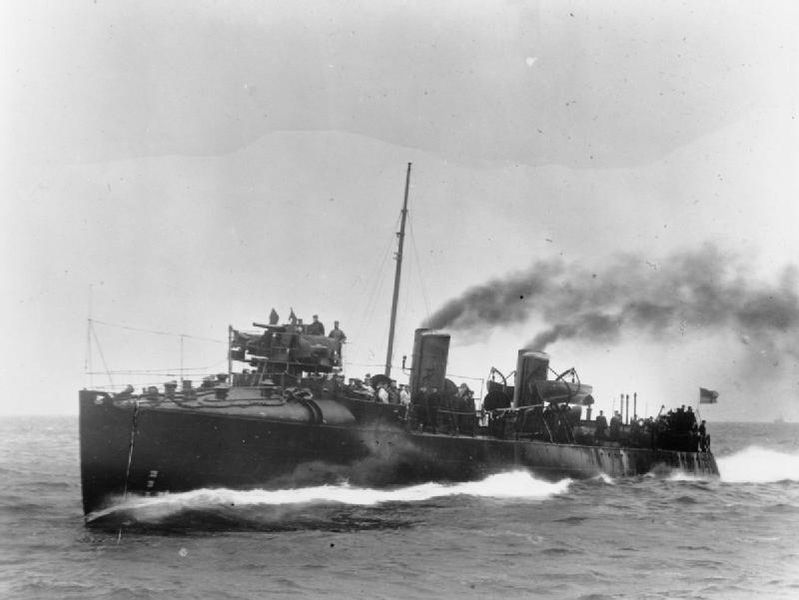
HMS Fame of the D-class TBDs (1896)
The HMS Albatross tried and re-tried to reach 33 knots during tests that lasted for two years, at the risk of breaking her machinery. She was the most successful of the three and was reformed in 1920. The HMS Express broke her test machines, and suffered from a bad reputation due to her many failures at sea.
She was reformed in 1921. Finally, the HMS Arab was started slightly after the first two so as to be improved during construction. But she was even more disappointing, struggling to reach 30.7 knots, and was reformed as early as 1919.
Technical specifications
Displacement: 465 t, 540 t FL
Dimensions: 73 x 7.16 x 3.12 m
Propulsion: 2 propellers, 2 engines, 4 boilers, 9250 hp. and 31 knots max.
Armament: 2 x 76mm guns, 4 x 47mm guns, 2 x 457mm TTs (axle).
Crew: 74
“River” type DDs (1903-1905)
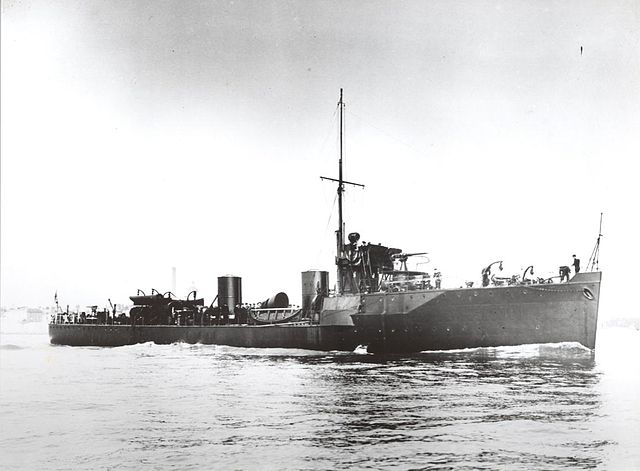
The “Rivers” (class “E” in 1912) were the first British destroyers built with a forecastle, giving away their traditional “turtleback” inherited from the architecture of the torpedo-boats. North Sea conditions required such an advance, to allow them to remain in squadron whatever the weather conditions, and accompany the fleet rather than staying in coastal stations.
We were leaving the concept of coastal ship definitively. A total of 34 units were commanded by the admiralty in 6 yards. It is Palmer that provides by far the largest workforce. However in 1914, the value of these ships was lower than the “Tribals”, because of their size, speed, and autonomy.
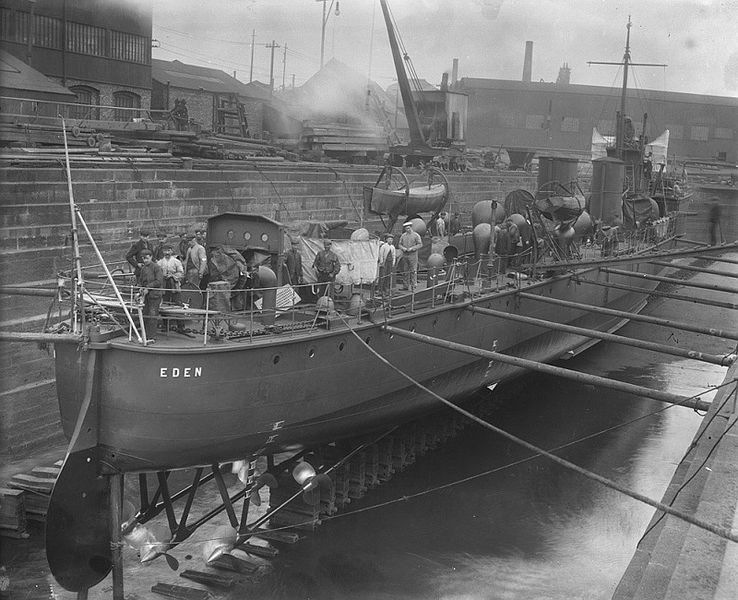
Two units did not participate in the Great War: The HMS Gala sank after a collision in 1908, and the HMS Blackwater in 1909 due to heavy weather. The others saw the fighting, and 6 were lost: HMS Erne after a shipwreck on a reef in 1915, HMS Derwent and Foyle jumping on mines, HMS Eden due to a collision and HMS Itchen at the following a torpedo. They gave full satisfaction in their escort and patrol missions and consummated the base of the future destroyers.

Profile of the River type
Technical specifications
Displacement: 550 t – 690 t FL
Dimensions: 71.2 x 7.2 x 2.9 m
Propulsion: 2 shafts TE steam engines, 2 boilers, 7000 hp. 25.5 knots
Armament: 4 x 76 mm, 2 x 457 mm TTs.
Crew: 52
“Cricket” class coastal destroyers (1906)
Technically classed as “coastal destroyers” but they were torpedo boats in all but name. The Royal Navy had TBs in the 1890s and maintained a sizeable fleet which was coastal in essence. The Crickets were intended to counterweight the massive fleet destroyers of the Tribal class, as a cheaper alternative for coastal duties. They were reclassed as torpedo boats in effect during the war.
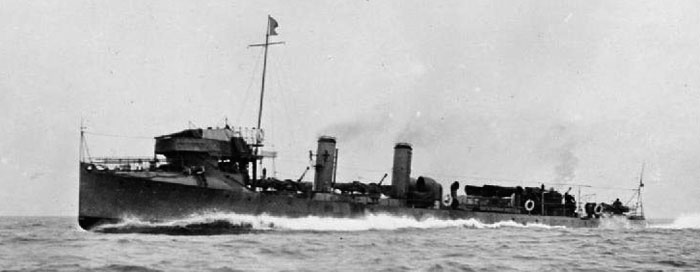
“Tribal” type DDs (1906-1907)
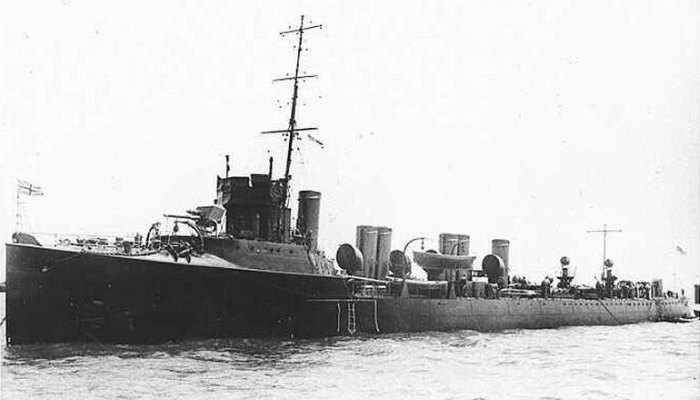
HMS Viking – Tribal Class
These 12 destroyers were the “darling children” of Admiral Sir John Fisher, promoted in 1904 first Lord of the Sea. Fertile brain, he imagined a new type of destroyer capable of higher speeds, to compose the future fleet of only Dreanoughts battleships and fast heavy destroyers.
The “Tribals” (named after tribal names of the empire), were the prototypes. Fisher had a very specific design for the various shipyards, stipulating the ability to stay 7 days at sea, to run on oil while being able to support 33 knots for 8 hours in a row, and to be armed with two 76 and 47 mm.
Later, these unrealistic claims were reduced to 4 days at sea and 3 pieces of 76 mm). In the end 8 yards answered present, in spite of the difficulties, and delivered each one or two buildings, launched in 1907, 1908 and 1909.
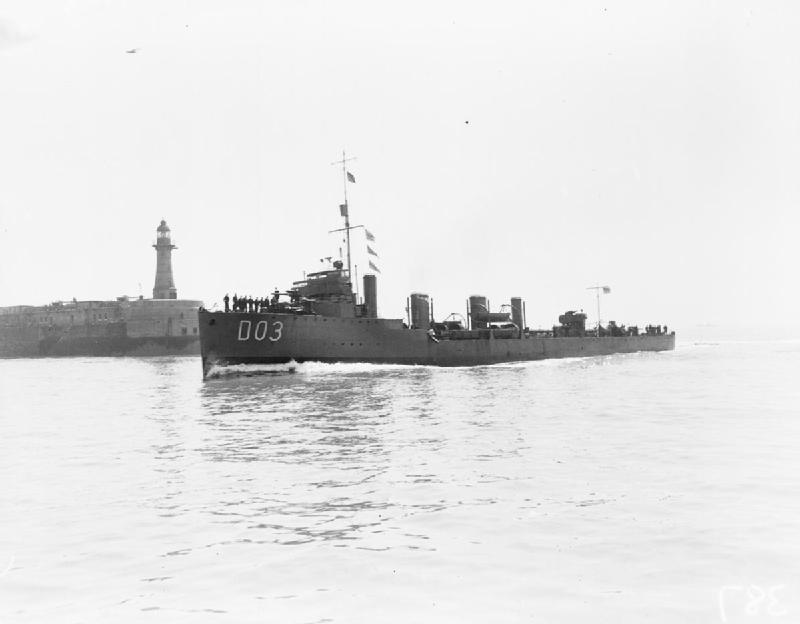
HMS Crusader, Imperial War Museum
However the plans delivered by their study offices had been more or less botched up in front of the requirement of Fisher to receive these within 11 days from the submission of the project. These ships were to be 7.5 knots faster than the River and to run on fuel alone, which was radically new and a major technical challenge for the engineers.
In fact, the “Tribals” were almost walkers, not marine, extremely greedy and therefore having a radius of action properly ridiculous. Finally, few could support or even reach the 33 specified nodes. All differed in size, weight, appearance, engines and power. They were assigned to the 6th Flotilla in 1910, then in 1914 passed to the Dover Patrol, as “Class F”.
Despite their shortcomings, they frequently fought against the German destroyers, and four were lost, two of them jumping on mines. Two of these destroyers, the Zulu and the Nubian, one with its jagged rear end and the other his forecastle, were towed, partially demolished, and wound together to form the “Zubian”, a rarity in the annals.

Profile of the Tribal type
Technical specifications
Displacement: 998t
Dimensions: 85.4 x 8.1 x 3 m
Propulsion: 3 shaft Parsons turbines, 6 Thornycroft boilers, 14,000 hp. 33 knots
Armament: 2 x 102 mm, 2 x 457 mm TTs.
Crew: 68
Beagle class destroyers (1909)
HMS Scourge – Beagle class
They constituted the first flotilla of destroyers in 1910, then the 5th before being sent in 1913 in the Mediterranean. They remained there (except 6 units reassembled to join the Home Fleet) until the end of 1917, fighting in particular with the Dardanelles. The HMS Wolverine was sunk following a collision, the HMS Racoon and Pincher were seriously damaged and their wrecks were abandoned in 1918.

Profile of the Beagle type
Technical specifications
Displacement: 1210t – 1330 t. FL
Dimensions: 76.2 x 10.1 x 3.4 m
Propulsion: 1 shaft TE steam engine, 2 boilers, 1800 hp. 16.5 knots
Armament: 1x 102mm gun, 3x 76mm, 2x 533mm TTs (axis, 4 torpedoes).
Crew: 96
Beagle class destroyers (1909)
In the 1908–1909 program of the British Admiralty, the Tribals were seen as an overkill, and the next destroyer should be smaller and more affordable. One of the core condition to keep it limited was to drop the required 33 knots. However they needed sufficient range for the North Sea and therefore the coastal Cricket-class came as a low-cost supplement of the Tribals outdated. Return to the use of coal because of concerns about the availability of oil stocks in case of war (and costs) was also mandatory. But they would be the last.
They carried five 12-pounder (76 mm) guns, i tandem on the forecastle, abreast, and aft but it was changed eventually to one BL 4-inch (102 mm) L/40 Mark VIII guns, mounting P Mark V, three QF 12-pounder 12 cwt Mark I, mounting P Mark I, and two single 21 inch (533 mm) torpedo tubes. During Wartime the aft torpedo tube was replaced by a 3-pounder (47 mm) AA gun on some, plus depth charges fitted. When the war broke out they were with the Mediterranean 5th Flotilla. By then they were known as the G class in October 1913. However because they were coal-fired they were quickly discarded, in 1921.

Profile of the Beagle type
Technical specifications
Displacement: 860 t – 940 t. FL
Dimensions: 83.8 x 8.4 x 2.6 m
Propulsion: 2-3 shaft Parsons turbines, 4 Yarrow boilers (coal), 12,500 hp. 27 knots
Armament: 1x 102 mm, 3x 75mm, 2x 533 mm TTs.
Crew: 96
Acorn class destroyers (1910)
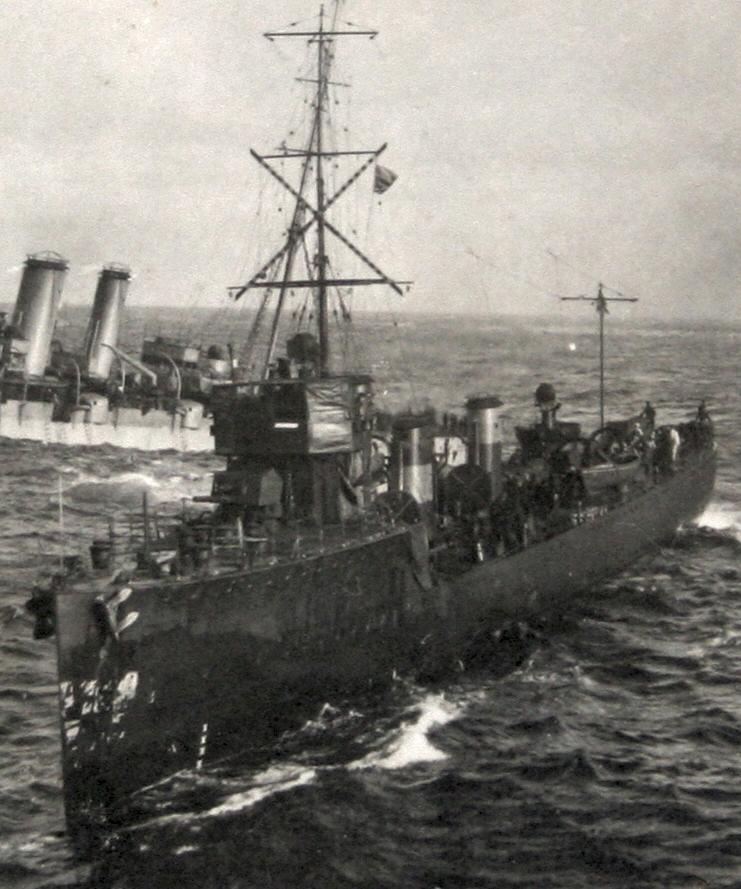
HMS Fury 1911
This class of 20 destroyers of the program of 1909 and 1910 constituted a return to the combustion of fuel oil, at the expense of speed, but in favor of endurance. It was the first time that the Admiralty submitted a design to various companies for contract.
They had three funnels, the first of which was then raised because of the inconvenience caused by the smoke on the bridge in case of tailwind. The first of these ships was completed in December 1910, the last in February 1912. They were to constitute an improvement of the “Beagle” while replacing the “River” of 1904-1908 within the 2nd flotilla.
In August 1914 they were transferred to the Grand Fleet and operated at Devonport. They were gradually affected in the Mediterranean, receiving a 47 mm AA gun, and deep-loads. The class, also called “class H” since 1913, counted three losses, of which only two in combat, HMS Stauch and Comet, torpedoed in 1917-18. The Goldfinch was lost at sea, being driven on reefs.
It was BU in 1919, reduced to wreckage. The others were demolished in 1920-21 except the Nemesis and Minstrel which were “rented” in Japan between 1917 and 1919.

Profile of the Acorn type
Technical specifications
Displacement: 772t – 970 t. FL
Dimensions: 75 x 7.7 x 2.6 m
Propulsion: 3 shafts Parsons turbines, 4 Yarrow boilers, 13,500 hp. 27 knots
Armament: 2x 102 mm, 2x 76 mm, 2x 533 mm TTs.
Crew: 72
Acheron class destroyers (1911)
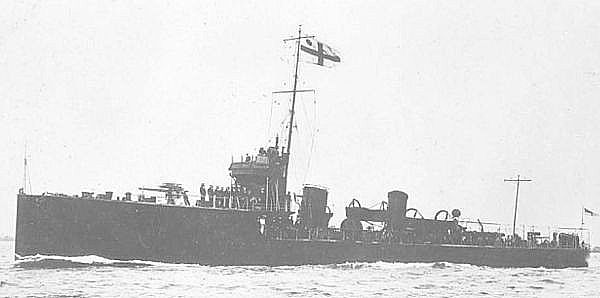
These 29 destroyers launched in 1911-12 and completed in 1912 (apart from three units of the Australian series built during the war) were virtually copies of the 1910 Acorns. There were 14 units designed by the Admiralty, but also 9 “specials” of three sites that were testing improvements, and 6 “Australians” including 3 built locally in Cockatoo, including Huon, Swan and Torrens.
These last two were operational in 1915. Although similar to the Acorn, the Acheron had two chimneys of the same height. The dimensions were virtually unchanged but the power and speed were slightly higher.
Put into service as the first flotilla, they were then assigned to the 3rd Battle Squadron, based in Portsmouth. Many of them were then sent to the Mediterranean.
Five ships were converted into mine anchors in 1917, and three were lost in action, the HMS Phoenix (torpedoed in 1918 during a night action), the Attack and the Ariel jumping on mines. Most were scrapped in 1921, but some survived until 1930-31 (the “Australians”).

Profile of the Acheron type
Technical specifications
Displacement: 778t – 990 t. FL
Dimensions: 75 x 7.8 x 2.7 m
Propulsion: 3 shaft Parsons turbines, 3 Yarrow boilers, 16,000 hp. 28-29 knots
Armament: 2x 102 mm, 2x 76 mm, 2x 533 mm TTs.
Crew: 72
Acasta class destroyers (1912)
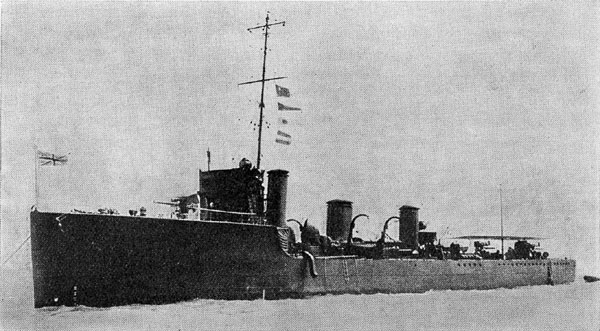
These 20 destroyers launched in 1912-13 and completed in 1913-14 followed the Beagle, Acorn, and Acheron lineage, but were a step forward in the area of improvements from the previous classes.
They were the largest British series destroyers since the “Tribals” of 1909. Their armament was standardized and simplified to 3 pieces of 102 mm quick-fire Mk.VIII of 45 calibres, supplemented always by 2 tubes of 533 mm in the axis with two torpedoes in reserve.
The old “12 pounder” (47 mm) had been abandoned because expensive to produce and too light to inflict serious damage. In addition, the originally planned speed of 32 knots was lowered to 29 as the quadrature of the circle (high speed with reduced tonnage) was arduous and was a source of problems for previous ships.
Their turning radius was also very high, and these ships were therefore not very manoeuvrable.
It was considered in the process of completion to rename these vessels beginning with the letter “K” and to designate the entire class as class “K”, but the admiralty renounced this idea because of the superstition of Navy seamen. when to renaming a ship.
There were also four special units that differed in details and arrangements according to the yards and were used to test solutions. These ships served in the 4th Squadron, led by HMS Swift.
There were a total of 7 combat losses in 1916-17. The others survived until 1921 before being dropped from the lists. HMS Porpoise continued his career under the Brazilian flag with the name of Maranhao. He was still active during the Second World War.

Profile of the Acasta type
Technical specifications
Displacement: 1072 t – 1300 t. FL
Dimensions: 81.5 x 8.2 x 2.9 m
Propulsion: 2 shaft Parsons turbines, 4 Yarrow boilers, 24,500 hp. 29 knots
Armament: 3x 102 mm, 2x 533 mm TTs.
Crew: 73
“L” class destroyers (1913)
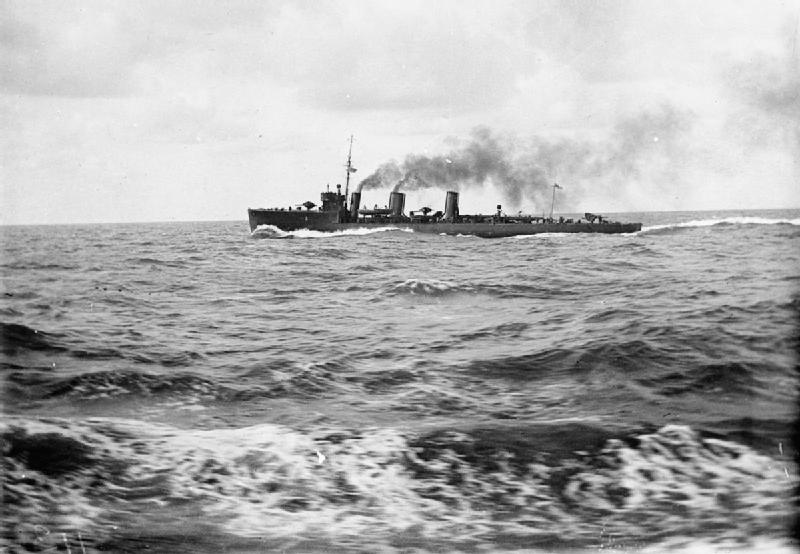
HMS Loyal
Also called Laforey class, named after the first unit started and launched on March 28, 1913, this series of 22 buildings was the last studied before the Great War.
Of the 22 launched, all but 2, built in the emergency in 1915 (“Repeat L” Beardmore yards – HMS Lochinvar and Lassoo) were operational at the time of the declaration of war in August 1914.
These ships were studied late 1912 in digesting the strong and weak points of the preceding classes, in particular Acasta. The Admiralty demanded 24,500 hp two-propeller ships, armed with three 4-inch semi-automatic guns, and two double torpedo benches. A slender bow was also preferred to the right bow, because more marine, and semi-engined turbines.
All but four had 3 fireplaces, also raised quickly. Their stern was also fitted with rails for anchoring the Elia or Ype H mines, but in operations they never had any use.
The original names of these units were derived from novels and short stories by Sheakespeare and Waverley, but by order of the Admiralty on September 30, 1913, which wanted to reorganize its classes with the alphabet, they were renamed “L”. This habit was preserved until the end of the Second World War.
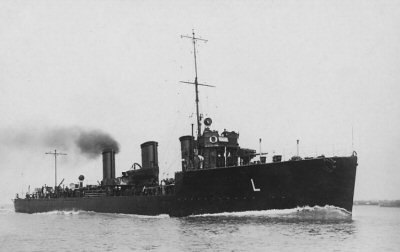
HMS Laertes
Upon their entry into service these ships were assigned to the 3rd squadron of destroyers at Harwich. In 1917, there were only three casualties, the Laforey who jumped on a mine in March 1917, the Lassoo in August 1916, and the Louis sunk by Turkish coastal batteries after being stranded in front of Suvla Bay (Dardanelles) in 1915 (4 units were sent there in 1915, re-named in 1916).
The remaining 19 units were dispersed between Devonport and Portsmouth for escort missions. The Lance had the honor of firing the first Royal Navy liner during the war, addressed to the German assistant mine-keeper Königin Luise. Six destroyers of this class fought and destroyed four German destroyers at the Texel on October 17, 1914. These ships were sold in 1921-22.
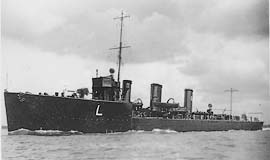

Profile of the L type, HMS Laforey
Technical specifications
Displacement: 965t, 1150 t FL
Dimensions: 81.9 x 8.4 x 3.2 m
Propulsion: 2 shaft steam turbines, 3 boilers, 24,500 hp. 29 knots
Armament: 3x 102 mm, 1 Maxim MG 7.07 mm, 4x 533 mm TTs (2×2).
Crew: 73
“M” class destroyers (1913)
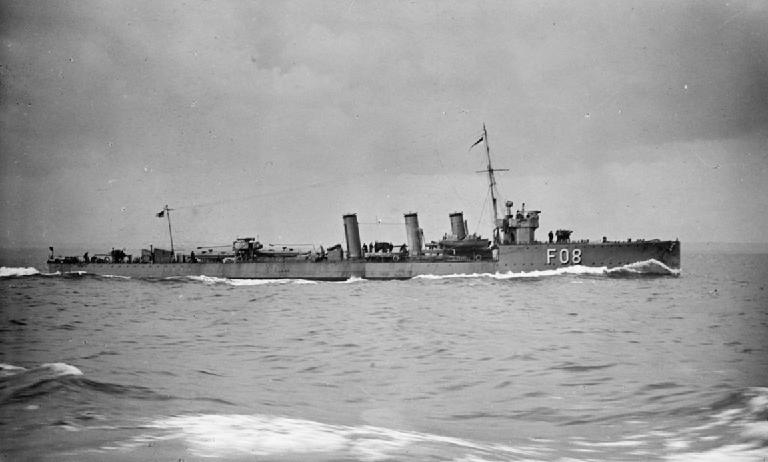
Succeeding the class “L” (1913), the “M” were distributed in squadrons of 5 ships (finally 13 in total), instead of the 20 normally expected (for budgetary reasons) and were largely based on the “L”.
Their construction was urgently made and purchased on plans between three designs, that of the Admiralty, that of Hawtworth Leslie whose ships had four fireplaces, Thornycroft, three, and Yarrow 2 fireplaces.
They were noticeably longer but narrower and lighter, and their power increased to gain 5 knots, according to the express request of Sir Winston Churchill, then newly appointed first Lord of the Admiralty. The bowels of these ships were laid in early 1914 and were launched from April to December 1914.
The Miranda was conducting its tests at the time of the attack in Sarajevo. At the trials one of them hung the 36 knots, and in calm seas, they should all reach between 34 and 35 knots, 33 in heavy weather. They served in the strength of Harwich, patrolled Dover, and from 1917 in the Mediterranean. The Meteor was converted at that time as a minelayer.
None was sunk in battle. Their rapid construction had as a corollary a limited life, and they were all disabled in 1921.
Profile of the M type
Technical specifications
-Displacement: 900t, 1000 t FL
-Dimensions: 82-83,6 x 7,8-8,3 x 2,6-3,2 m
-Propulsion: 2 shaft steam turbines, 4 Yarrow boilers, 23,000/27,00 hp. 34-35 knots
-Armament: 3x 102 mm, 1 Bofors 2-pdr AA, 4x 533 mm TTs (2×2).
-Crew: 76-83
“Repeat-M” class destroyers (1915)
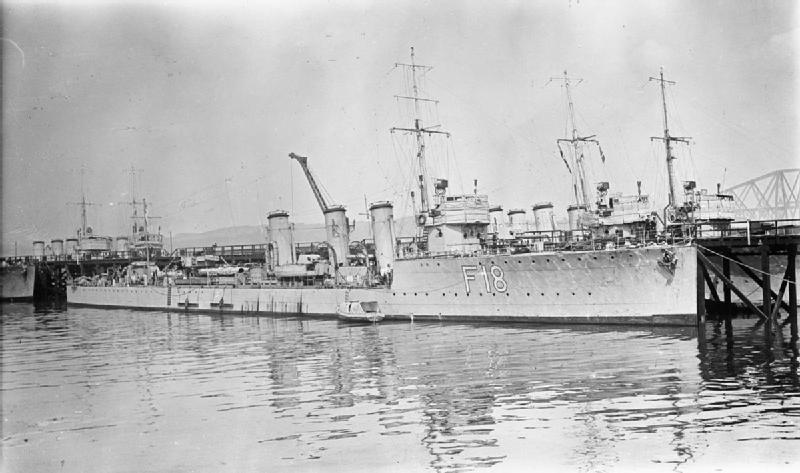
HMS Paladin 1916 – Imperial War Museum
The first big series of destroyers of the war, were to gain time based on the “M” of 1914. In reality, the whole class was so important (89 units), that it was divided into subclasses M, N , O and P.
The vast majority was designed by the admiralty and 11 special plans of the two major shipyards specialists: Yarrow and Thornycroft. The decision was made by the Admiralty in September 1914 to renew an order of “M”, 16 based on the design of the Admiralty, to three boilers, and without secondary cruise turbines except for a few buildings while a couple specials funnels, while the propulsion standards differed, some having three propellers, others two, some of the turbines fully engaged and most half-engined.
They also differed in hull details, the “specials being longer with a bowed bow and a flared stern, all of which also had a reinforced bow to facilitate the ramming of the U-Bootes.”
By August 1914, this faculty had been requested by many captains of destroyers.) The “M bis” also had the standard 102 mm center raised on a platform, the first launched was one of Yarrow’s four “specials”, the HMS Moon on April 23, 1915, followed by two series ordered in November 1914, one in February 1915, and the last in April 1915.
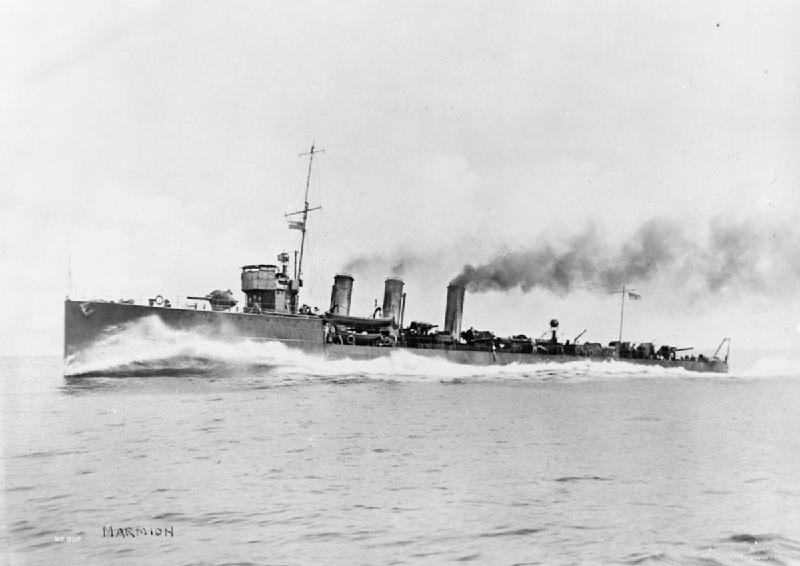
HMS Marmion in 1915
All these buildings were issued from the end of 1915 to the end of 1916. Although built in urgency and criticized for their sloppy finish, with the galvanized steel, they withstood the four years of war in the North Sea with continuous action and rare passages in dry dock, but in 1919 they were retired and most of them demolished in 1921. were rare:
The Mary Rose was sunk by the Brummer and Bremse cruisers in the North Sea in 1917, the North Star in 1918 during the Zeebrugge raid, and the Nestor and Nomad during the Battle of Jutland and the Partridge in the following a duel of destroyers in sleeve. Marmion, Negro and Nessus were lost as a result of collisions.
The last four Thornycroft and Yarrow specials survived until 1926 and both Yarrow RCN until 1929.
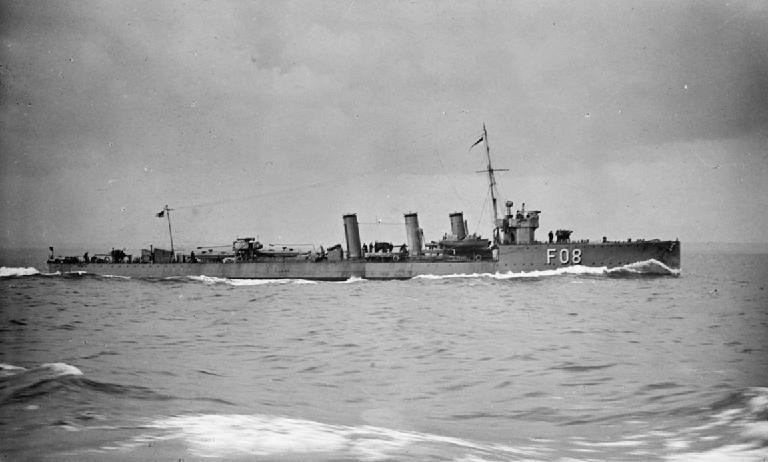
HMS Oracle in 1915 – IWM

Profile of the ‘M-Bis’ type
Technical specifications
-Displacement: 95-1025t – 1250 t. FL
-Dimensions: 83 x 8.2 x 2.6-2.9 m
-Propulsion: 2-3 turbines, 3 boilers, 23-26,500 hp. 34-35 knots
-Armament: 3 x 102mm, 1 x 40mm AA, 4 TLT 533mm (2×2) guns.
-Crew: 80
Medea class destroyers (1913)
Four ships (Medea, Medusa, Melampus, Melpomene) built for the Greek Navy when WWI broke out, taken over and completed for the Royal Navy. They were a private design roughly based on the M-class destroyers. With three funnels with the foremost taller, taller mainmast than the foremast and three single QF 4 inch guns, (forecastle, between the two funnels, quarterdeck).
Technical specifications
-Displacement: 1040-1060 t. FL
-Dimensions: 83.36 x 8 x 3.2 m
-Propulsion: 3 Yarrow turbines, 3 WT boilers, 25,000 hp. 32 knots
-Armament: 3 x 102mm, 1 x 40mm AA, 4 TLT 533mm (2×2) TTs.
-Crew: 80
Faulknor class Flotilla Leaders (1914)
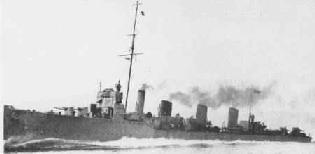
HMS Broke
The Faulknor class were a class of flotilla leaders ordered for the Chilean Navy and requisitioned when the war broke out. Of the six ships, Almirante Lynch and Almirante Condell were delivered only. The remainder were completed for the Royal Navy, named after famous Royal Navy captains. They were a private design by J. Samuel White, faster, larger and more heavily armed, and therefore they were reclassed and used as flotilla leaders.
They all fought at the Battle of Jutland where hms Broke collided with and sank the Acasta-class destroyer Sparrowhawk. HMS Tipperary (4th Destroyer Flotilla) was badly hit by a 6-in shell from SMS Westfalen and sank. In April 1917, HMS Broke took part in the Battle of Dover Strait and was damaged there. HMS Botha was damaged in Channel on 21 March 1918, after ramming and sinking the A-19, and torpedoed in error by the French destroyer Capitaine Mehl.

Profile of the HMS Lightfoote
Technical specifications
-Displacement: 1700t, 1850t FL
-Dimensions: 101 x 9.9 x 3.4 m
-Propulsion: 3 shaft steam turbines, 6 White-Forster boilers, 36,000 hp. 32 knots
-Armament: 46x 102 mm, 2x 40 mm (2-Pdr), 4x 533 mm TTs (2×2).
-Crew: 200
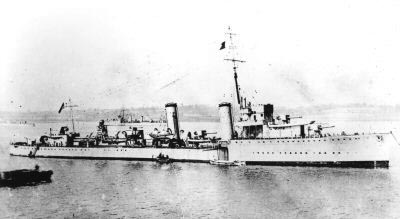
HMS Scott circa 1917
Marksman class flotilla leaders (1915)
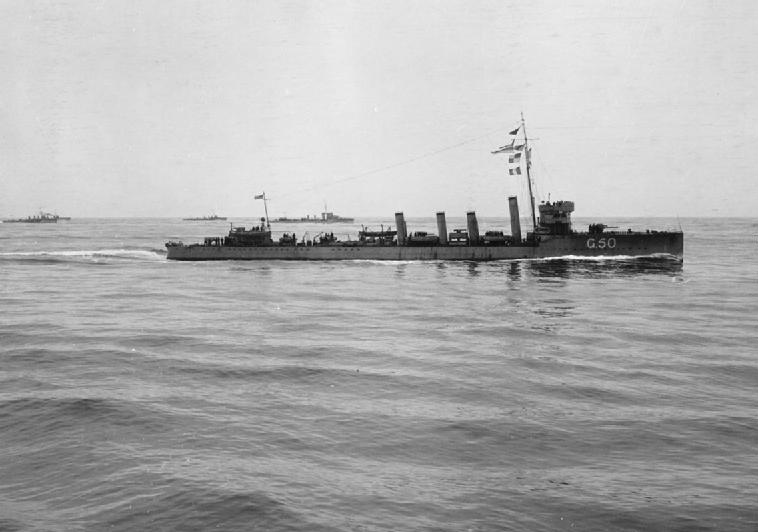
HMS Ithuriel
In 1912, with the unsuccessful Swift and the disappointing result of light scouting cruisers in terms of speed, it came back to the solution of the great flotilla destroyers, a solution that would first be unique to Britain, as far as 1919, then to France in 1924 and to Russia in 1930.
The Lighfoote class consisted of 7 units, and was intended to lead 7 flotilla of 8 units, for the L and M classes to begin. A conference of the admiralty took place in 1912 to determine exactly their characteristics.
There was agreement for an enlarged version of the “Tribal”, with a large gangway to accommodate officers and signal organs in the flotilla, and a consequent DCA to provide air protection to the flotilla. It came at a reasonable top speed (33 knots, which was greatly exceeded in the tests) and machines simply derived from destroyers class “M”.
Two were first approved in 1913 (Marksmann and Nimrod), then two others (Kempenfelt and Lightfoote), launched in April-May 1915. Three more (Abdiel, Gabriel and Ithuriel) were approved after the beginning of the war, launched in October and December 1915, and the last one in March 1916.
Some underwent modifications of armament, like the Abdiel turned into minesweeper, or the Gabriel later, the Lightfoote and the Nimrod receiving two torpedoes of 355 mm at short range for nocturnal actions. They fought in the Channel and the North Sea and were all disabled in 1921 with the exception of Abdiel in 1936.

Profile of the M type, HMS Lightfoote
Technical specifications
-Displacement: 1600t, 1626t FL
-Dimensions: 98.8 x 9.7 x 3.7 m
-Propulsion: 3 shaft steam turbines, 3 boilers, 36,000 hp. 34 knots
-Armament: 4x 102 mm, 2x 40 mm (2-Pdr), 4x 533 mm TTs (2×2).
-Crew: 116
Parker class Flotilla Leaders (1915)
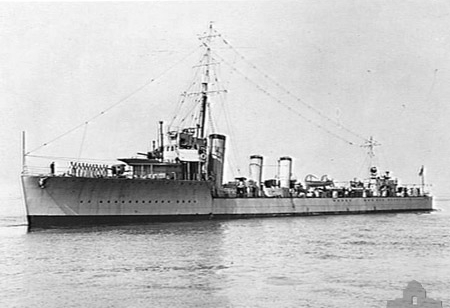
Generally considered as improved Marksman-class leaders, six destroyer leaders built in 1916-17 and named after famed historical naval leaders except the Australian ship. The last major Royal Navy warships ordered with three propeller shafts. Compared to the Marksman they had more freeboard, better firepower, and their bridge moved further aft. This was done by reducing the boiler rooms from three to two. Therefore they had three funnels, the foremost funnel thicker and taller. Free of smoke, a superfiring gun was added on a shelter deck, a crucial design improvement repeated on later designs. Not only both had a way better arc of fire, but they were free of seaspray in heavy seas.
The Anzac one was the only one with increased freeboard. The other major innovation was an adoption of a smaller, simpler version of cruisers and battleships director firing system. The gun crews no longer had to aim and fire their guns independently. A gyroscope was used for the best accuracy. It was soon deployed “V and W” destroyer in 1917 and following classes. The Parker, Grenville, Hoste, Seymour, Saumarez, Anzac were very active during the war but were broken up in the interwar, the last in 1935. The only loss was HMS Hoste, lost following a collision with HMS Negro 21 December 1916 off the Shetland Islands.
Technical specifications
-Displacement: 1670t, 1700 t FL
-Dimensions: 99 x 9.7 x 3.2 m
-Propulsion: 3 shaft Yarrow steam turbines, 3 Yarrow boilers, 36,000 hp. 34 knots
-Armament: 4x 102 mm, 1x 12pdr (3-in), 2x 2pdr AA, 4x 533 mm TTs (2×2).
-Crew: 116
Talisman class destroyers (1915)
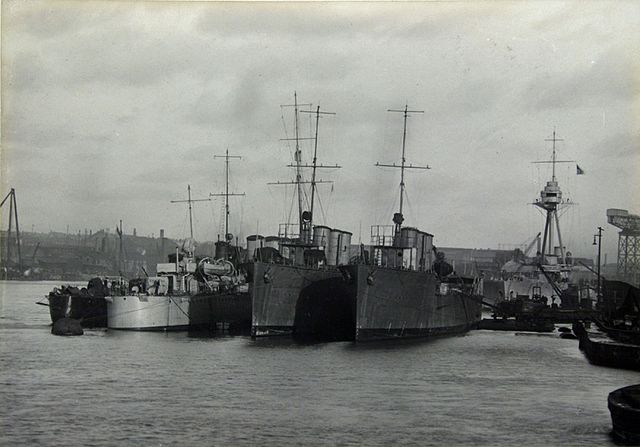
The Talismans were originally designed by Armstrong Whitworth for the Ottoman Navy, sub-contracted to Hawthorn Leslie. They were powered by three Parsons direct-drive steam turbines, enough for a 32 knots design speed (59 km/h; 37 mph). They carried 237 long tons (241 t) of fuel oil.
They were well-armed, with five single QF 4-inch (102 mm) Mark IV guns, the first two side-by-side on the forecastle, the other guns on the centerline. In addition, as designed they had three twin 21-inch (533 mm) torpedo banks, but only two when completed.
They were indeed requisitioned while in construction, completed in 1916 and immediately pressed into service. HMS Talisman was the only loss, Sunk by the German battleship Westfalen during Battle of Jutland. Their hull form was considered very successful and was copied for the next V-W classes in 1917.
Technical specifications
-Displacement: 1098t, 1116 t FL
-Dimensions: 94 x 8.7 x 2.9 m
-Propulsion: 3 shaft steam turbines, 3 yarrow boilers, 25,000 hp. 32 knots
-Armament: 5x 102 mm, 4x 533 mm TTs (2×2).
-Crew: 102
Shakespeare class flotilla destroyers (1916)
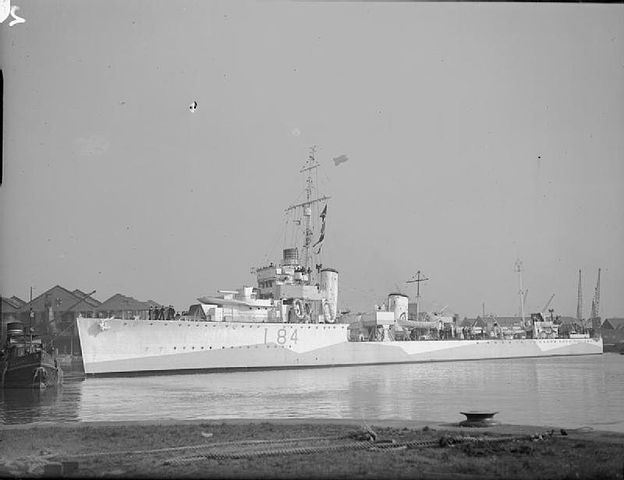
These ships were to take the new squadrons of class V destroyers, but also to fight the new German destroyers armed with 140 mm pieces, according to a nagging rumor that the secret services took time to deny. It was Thornycroft who presented these ships to the Admiralty and saw his project approved. However, due to the lack of modern and adaptable 140 mm pieces, it fell back on a tried and tested 120 mm or 4.7 inches) diameter field piece.
These ships were therefore the first British destroyers armed with this new type of superior artillery, plus five pieces while the standard destroyers had only three. As rumors quickly fell, (although proven in 1918 with the late S113 Germans), the Shakespeare were the most powerful destroyers in the west.
7 ships will be ordered in 1916, 17, 18, two cancelled in April 1919, and two others (Rooke and Keppel) delayed and completed in the 20’s. Only the first three, Shakespeare, Spenser and Wallace, participated in the conflict.
They were assisted by the Scott built at Cammell Laird. The HMS Rooke will then be renamed Broke, while Shakespeare and Spenser broken up in 1936. In 1939, therefore remained on duty Wallace, Broke and Keppel.
The Broke was the only one to be lost in a mission, sunk on November 8, 1942 by a French coastal battery in Algiers during the operation “Torch”. HMS Wallace will be rebuilt as an AA destroyer, the other two served as escort destroyers.
For Conway’s the class is often called “Shakespeare class” and associated closely to HMS Broke. These ships were derived from several private designs from Thornycroft, the Regele Ferdinand-class (built in Italy for Romania), the Churruca-class for Spain, and the Mendoza-class for Argentina. The first two were associated with the war emergency program of April 1916, the first two under the War Emergency Programme (Shakespeare and Spencer), and the third (Wallace) in April 1917. Only the thord participated in WW2, as she was completed in February 1919. The other two served during WW1, Shakespeare being badly damaged by a mine in June 1918.
At last another serie was ordered in April 1918: The Keppel, Broke, Saunders and Spragge but the last two were cancelled and the first two launched in 1920 and completed in 1925 are a bit off-topic. All these ships were very active during WW2, often with the TT banks removed and additional AA and DCT added.

Profile of the HMS Shakespeare in 1942
Technical specifications
-Displacement: 1554t, 2010t FL
-Dimensions: 100.3 x 9.6 x 3.8m
-Propulsion: 2 shaft steam Brown-Curtis turbines, 4 Yarrow boilers, 40,000 hp. 36 knots
-Armament: 5x 120 mm, 1 x 76mm, 2 x 40mm AA Bofors, 6 x 457mm TLT (2×3).
-Crew: 183
‘R’ class destroyers (1916)
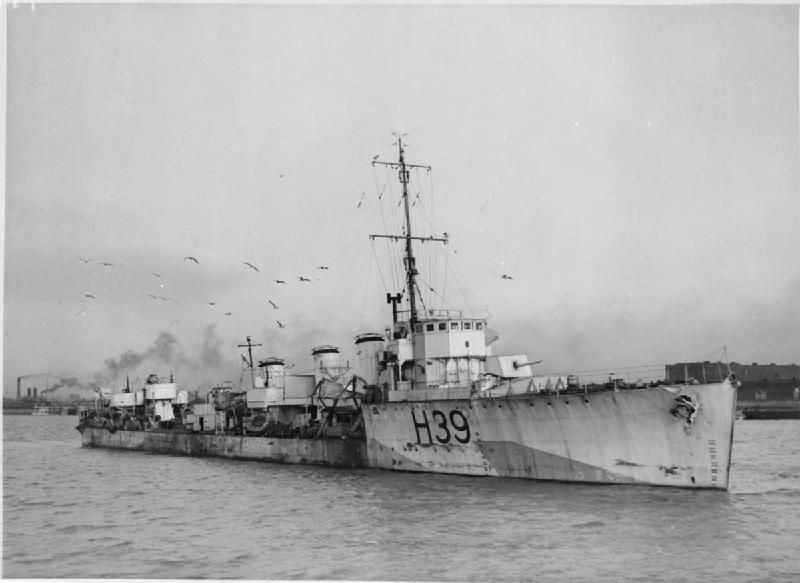
The Admiralty after criticisms concerning the “M” wanted to rationalize the production, and issued a new destroyers standard systematically equipped with two propellers with two direct drive Brown-Curtis turbines, after taking into account the complacent report made the behavior of HMS Lucifer and Leonidas (Yarrow, 1913) in use.
All of them had three round funnels, including Thornycroft’s 5 specials and Yarrow’s 7. Their hull and their arrangements were modeled on the “M”. The forecastle was slightly raised, the hull slightly reinforced, as well as the bridge.
This class “R” actually comprised 51 buildings divided into subclasses R, S and T. The first completed was the HMS Romola, launched in April 1916. These buildings, the last of which were launched in August 1917 were in all respects more enduring, fast, efficient, and strong than the “M”.
They stayed longer in service, being demolished only in 1926-29. There were only 6 casualties in battle: The Strongbow was sunk by the Brummer, the Simoom torpedoed by the S50. Four were in the middle of a minefield in December 1917, three were sunk, the Torrent, Surprise and Tornado, and the Radiant survived and returned safely.
HMS Ulleswater was torpedoed by the UC17 on the Dutch coast in August 1918. Some were still active in 1939: The HMS Skate, which participated in the Second World War, and the Radiant, which after repairs and a few years of service was sold in Siam in 1920 and was still sailing in 1960 under the name of Phra Ruang.

Profile of the R type
Technical specifications
-Displacement: 975 – 1173 t. FL
-Dimensions: 84,1 x 8,1 x 2,7 m
-Propulsion: 2 shaft Brown-Curtis steam turbines, 3 boilers, 27,000 hp. 36 knots
-Armament: 3x 102 mm, 1x 2-pdr (40 mm) AA, 4x 533 mm TTs (2×2).
-Crew: 83
‘S’ class destroyers (1917)
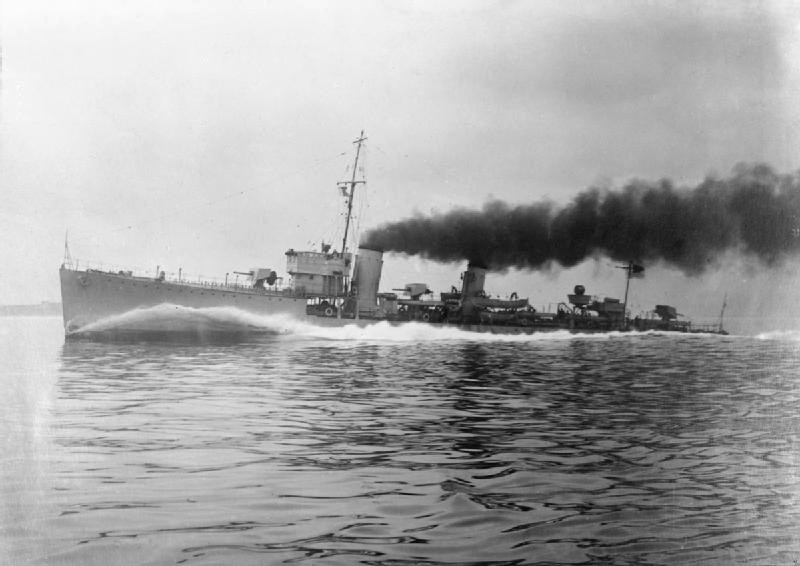
When the rumors and reports about the mass destruction of large destroyers by Germany fell in 1917, it was suggested to return to a more rational and economical destroyer model. This was class S, largely inspired by the last class M units.
They kept the long forecastle and the general appearance, as well as the propulsion, the hull, but incorporated some improvements from reports of officers. and captains.
The hull was modified at the bow to optimize the use of ASM grenades, torpedoes of added reserves, the central parts and before raised on platforms, an added projector, mounted on the rear bench of TLT. The “S” and “T” were ordered in two series, one in April 1917, and another in June, and there were again special series, 5 Thornycroft and 6 Yarrow.
The former had received two additional 457mm fixed tubes for night actions, common in the round against destroyers based in Belgium and Holland. Their late construction meant that only 19 were completed at the time of the armistice and a dozen accepted in service.
A dozen were launched in 1919 and the triple completed on that date. Solid, fast and enduring, these destroyers, compared to the V and W, suffered from their small size and were therefore less marine than the latter. Yet 11 participated in the Second World War. The series was to include a total of 56 buildings, but two were canceled in 1919.

Profile of the S type
Technical specifications (Admiralty design)
-Displacement: 970 – 1075 t. FL
-Dimensions: 84.1 x 8.1 x 2.7 m
-Propulsion: 2 shaft Brown-Curtis turbines, 3 Yarrow boilers, 27,000 hp. 36 knots
-Armament: 3 x 102mm, 1 x 40mm AA, 4 TLT 533mm (2×2) guns.
-Crew: 90
Repeat ‘R’ class destroyers (1918)
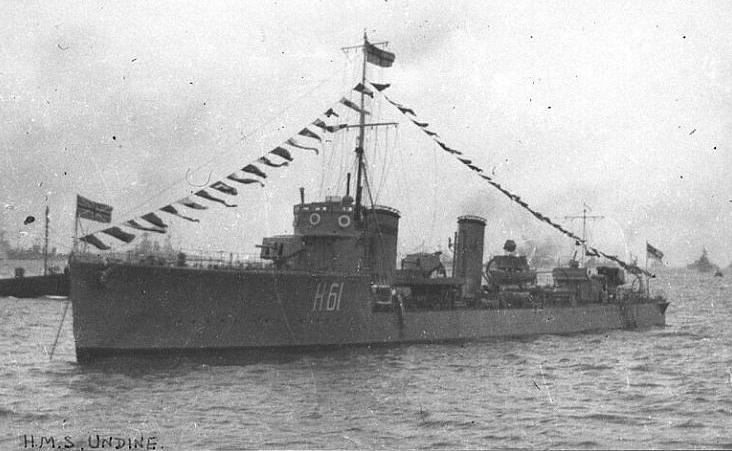
Officially classified in the last order of the class “R” comprising 26 units, 11 differed from the admiralty design to the point of constituting a new class.
These “modified Rs” had to have a footbridge on the back as much as possible, which lengthened the length of the forecastle and decreased the length of the deck, and the hull reinforced drastically.
All this was the result of the first years of service of the “M”, constantly subject to the bad weather conditions of the North Sea. These important modifications led to joining the evaporation of the first boilers into a single larger chimney.
The Brown-Curtis turbines were single-reduction, and the 102 mm Mk5 pieces had a 30 ° increase, allowing a range of 10,800 meters, with a rate of 20 strokes/minute, one every 33 seconds.
They were launched between December 1916 (Trenchant) and October 1917 and the majority served in the Harwich fleet. They were removed from service between 1921 and 1930 and they largely inspired the following “S”, the last mass series of so-called “light” destroyers (in comparison with the future V and W). The names of these ships began with U and T.

Profile of the ‘repeat-R’ type
Technical specifications (Admiralty design)
-Displacement: 975 – 1173 t FL
-Dimensions: 84,1 x 8,1 x 2,7 m
-Propulsion: 2 shaft Brown-Curtis steam turbines, 3 Yarrow boilers, 27,000 hp. 36 knots
-Armament: 3x 102 mm, 1x 40 mm AA, 4x 533 mm TTs (2×2).
-Crew: 82
‘V’ class flotilla leaders (1917)
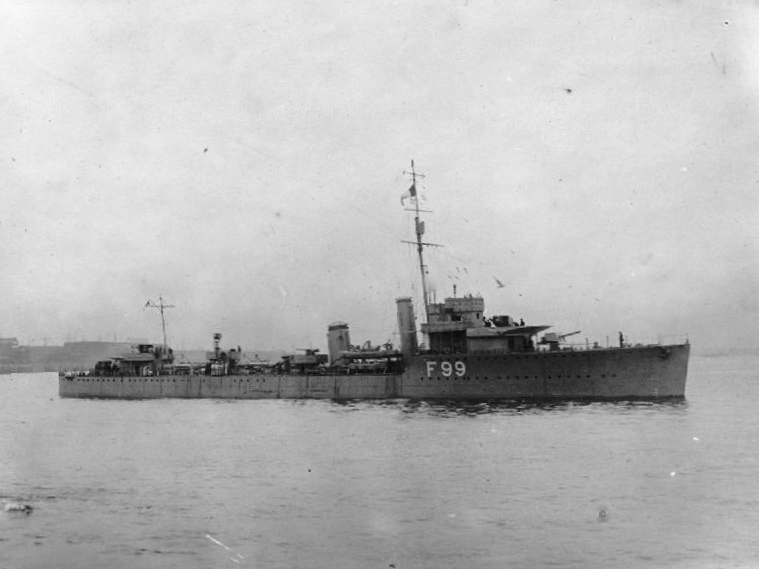
Under the term V-W lays the amalgam of six subclasses of destroyers under the war emergency program. They arrived late but soon enough to see little service in the War. During the interwar they formed the backbone of the Royal Navy’s destroyer flotillas and by the mid-1930s most were sent to the reserve. However they saw also extensive service during the Second World War as convoy escort, often with modernizations and tailored ASW armament. This way, they freed more modern models to serve with the fleet.
They embodied all improvements of their predecessors as well as innovations. What is amazing is that they were originally designed as flotilla leaders, but turned to be the new standards for British destroyers, quite an upgrade on existing designs worldwide. There was a more sensible layout of the main armament, with the middle gun moved to the aft shelter deck, superfiring. This added to the front superfiring gun as well. A more modern fire director firing for the main armament was setup, and triple torpedo tubes. The latter were known as the Admiralty W class and those with the armament upgraded to the BL 4.7 in guns became Admiralty Modified W class ships.
There were five Admiralty V-class leaders originally, Valentine, Valhalla, Valkyrie, Valorous, Vampire all completed in 1917. They displaced 1,188 long tons (1,207 t), for 312 ft (95.1 m) (o/a) by 29 ft 6 in (9.0 m) in width and a draught of 11 ft 9 in (3.6 m) deep, and an installed power of 27,000 shp (20,134 kW) for three Water-tube boilers.
Propulsion: two shafts steam turbines, 34 knots (63 km/h; 39 mph), Range 3,500 nmi (6,500 km; 4,000 mi) at 15 knots (28 km/h; 17 mph), Complement 134. They were armed with four single QF 4 in (102 mm) Mk V guns, one single QF 3-inch (76 mm) 20 cwt AA gun and two twin 21-inch (533 mm) TTs.
The admiralty V class differed by some points; They were generally lighter at 1,090 long tons (1,110 t) of displacement and armed with four single QF 4-inch Mk V guns, one single QF 3-inch 20 cwt or 1 × QF 2 pdr (40 mm) Mk II “pom-pom” AA gun and twin 21-inch torpedo tubes. These were 23 vessels ordered in July 1916 as Admiralty V-class leaders repeats. They resulted or alarmist reports of powerful German destroyers like the S 113. They were all completed with two twin torpedo tubes but from in 1921 they had their forward bank replaced by a triple bank and from 1923 the aft bank was swapped again for a total of six torpedoes, with few exceptions. These vessels completed in 1918 were very active duing WW2.
The Admiralty W class comprised 21 vessels ordered in December 1916. They had minimal changes but were fitted with triple torpedo tubes and a taller mainmast. Completed in 1918, they saw both the end of the war and WW2 where they were very active.
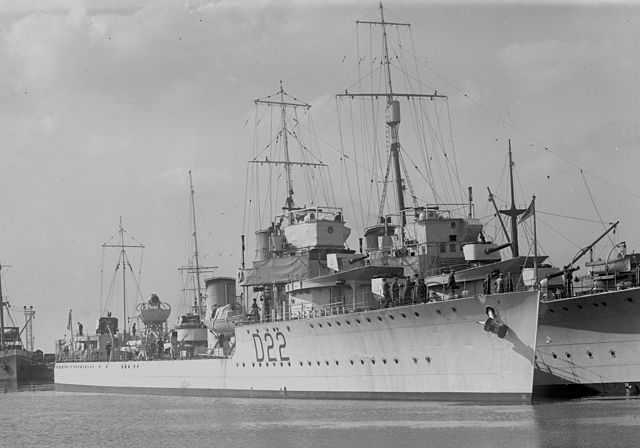

Profile of the V type
Technical specifications
-Displacement: 965t, 1150 t FL
-Dimensions: 81.9 x 8.4 x 3.2 m
-Propulsion: 2 shaft steam turbines, 3 boilers, 24,500 hp. 29 knots
-Armament: 3x 102 mm, 1 Maxim MG 7.07 mm, 4x 533 mm TTs (2×2).
-Crew: 73
Scott (Admiralty type flotilla leader) (1917)

Profile of the HMS Campbell
The Scott class were eight flotilla leaders developed at the end of the war. They were called officially “admiralty type flottilla leaders”, and were close to the V-W design but enlarged to carry additional and crew with offices and signalling equipment and the fifth gun of the flotilla leaders. Although they were close to the Thornycroft type leaders, instead of having had broad, slab-sided funnels they had thinner ones of equal size. The class comprised the Scott, Bruce, Douglas, Campbell, MacKay, Malcom, Montrose, Stuart, Barrington and Hugues. The last two were cancelled in 1918, all the others but MacKay and Malcolm participated in WW1, some to WW2 as well.
HMS Scott was torpedoed by U-boat 15 August 1918 in the North Sea off the Dutch coast, the Bruce missed ww2 as she was sunk as target off the Isle of Wight on 22 November 1939. All the others served in WW2, broken up in 1946-47. They were armed by three QF 6-pounder (57 mm) 10 cwt mountings instead of single 4.7 in mounts.
Technical specifications
-Displacement: 1580 t, 2053 t FL
-Dimensions: 98.3 x 9.7 x 3.8 m
-Propulsion: 2 shaft Yarrow turbines, 4 boilers, 40,000 hp. 36.5 knots
-Armament: 5x 120 mm, 1 x76 mm, 6x 533 mm TTs (2×3).
-Crew: 73
‘V’ class destroyers (1917)

Profile of a V type
The “V” class marked a new stage in the design of the world’s destroyers. They were much larger than the usual standards, the “M”, “R” and “S”, and seemed to be modeled on the “leaders” or flotilla leaders. It all started with rumors and a secret service report alleging the mass construction of heavy destroyers for the Hochseeflotte. The latter (which were finally less than a handful in construction, and two completed, the S113 and V116) were indeed officially named “Zestörer”, and not “Hochseetorpedoboote”, and their hull, their tonnage and especially their armament (152 mm pieces) made them formidable.
Sir W. Churchill, without waiting for further reports, demanded in June 1916 the urgent construction of “copies” of class V leaders (1917) designed for “R” class squadrons.
Thus the time of conception was reduced by the same amount, but the cost and the capacities of this class made a prodigious leap. A new standard was born, more in connection with the “Novik” and their successors Russians or projects of Japanese destroyers of 1918.
However, by compromise, they were endowed with a much more modest armament than the original “leaders”: 4 102 mm pieces and two double benches instead of the recommended triples. They were also simplified compared to the latter, sacrificing especially the card room useless.
The first were launched in July 1917 and the last in April 1918, in service from August 1917 to June 1918. As of January 1917, 4 were modified as mine layers, followed by six others. The HMS Vehement jumped on a mine in August 1918, the HMS Verulam in 1919 and the HMS Vittoria was torpedoed by a submarine Russian “Red” in the Baltic.
Much more sailor than the M, R, and S, they had a long career (two world wars) and were followed by the W, setting a new world standard for destroyers in the 20-30’s.
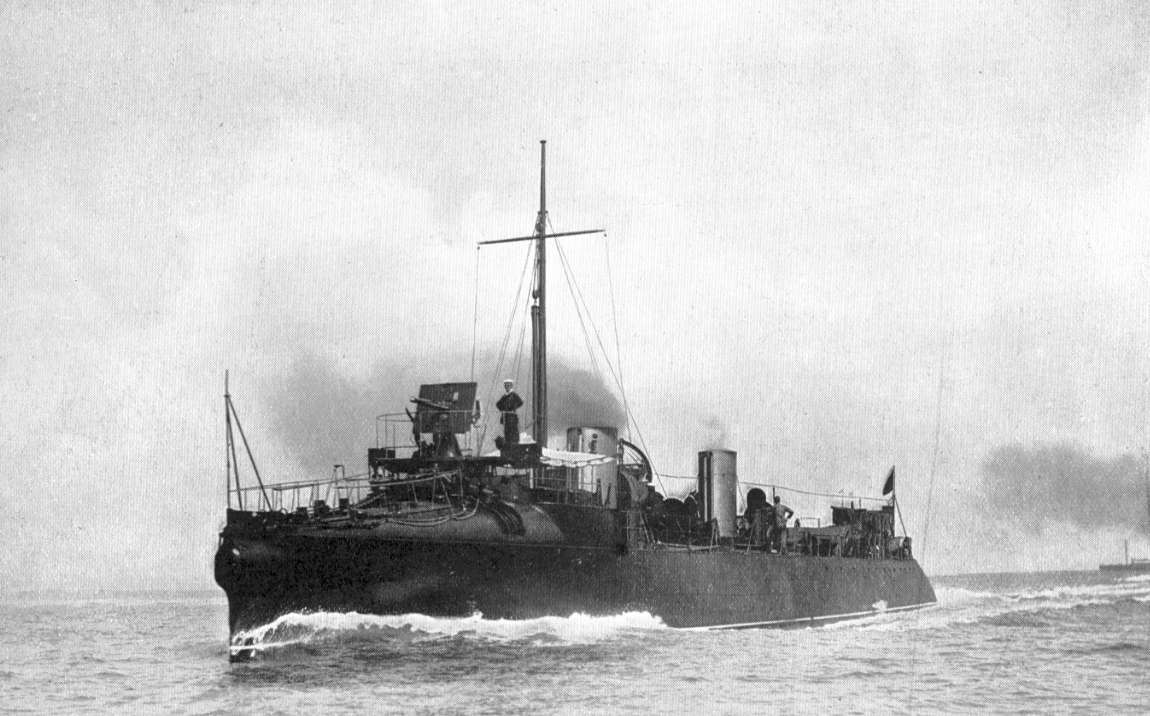
Technical specifications
-Displacement: 1100 – 1490 t. FL
-Dimensions: 95.1 x 9 x 3.2 m
-Propulsion: 2 shaft Brown-Curtis turbines, 3 Yarrow boilers, 27,000 hp. 34 knots
-Armament: 4x 102mm guns, 1x 76mm AA, 4x TLT 533mm (2×2).
-Crew: 134

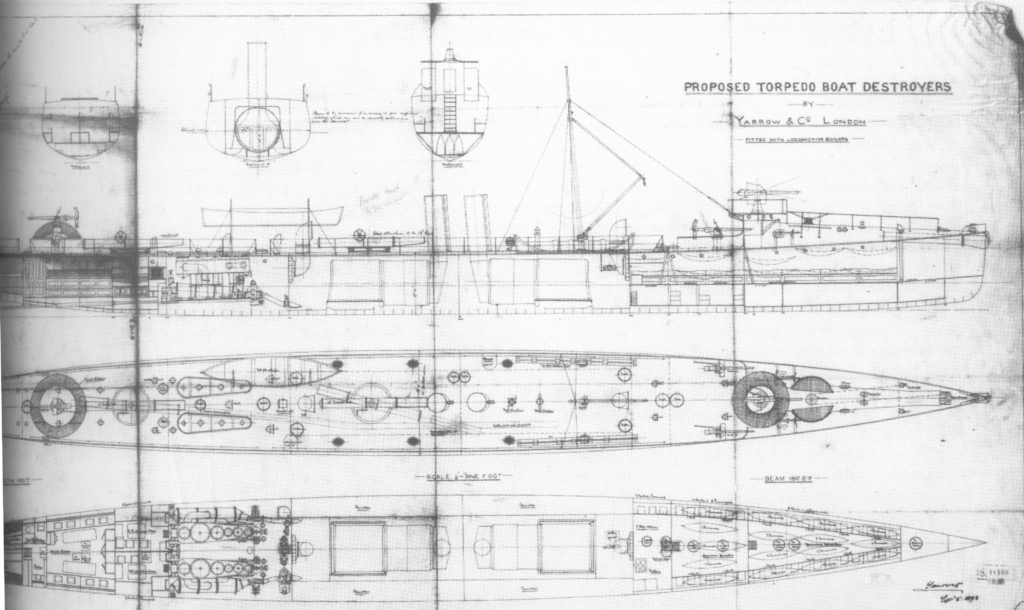
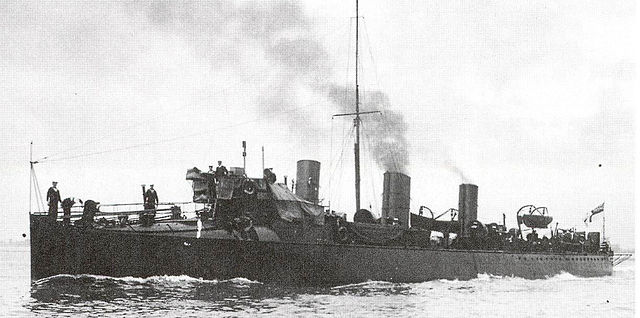

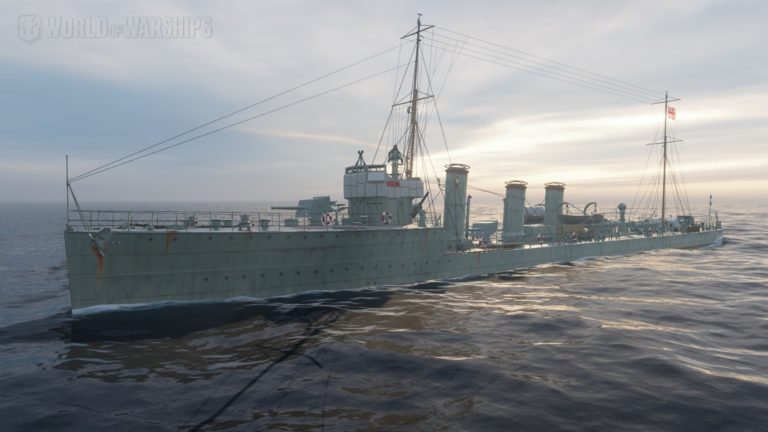
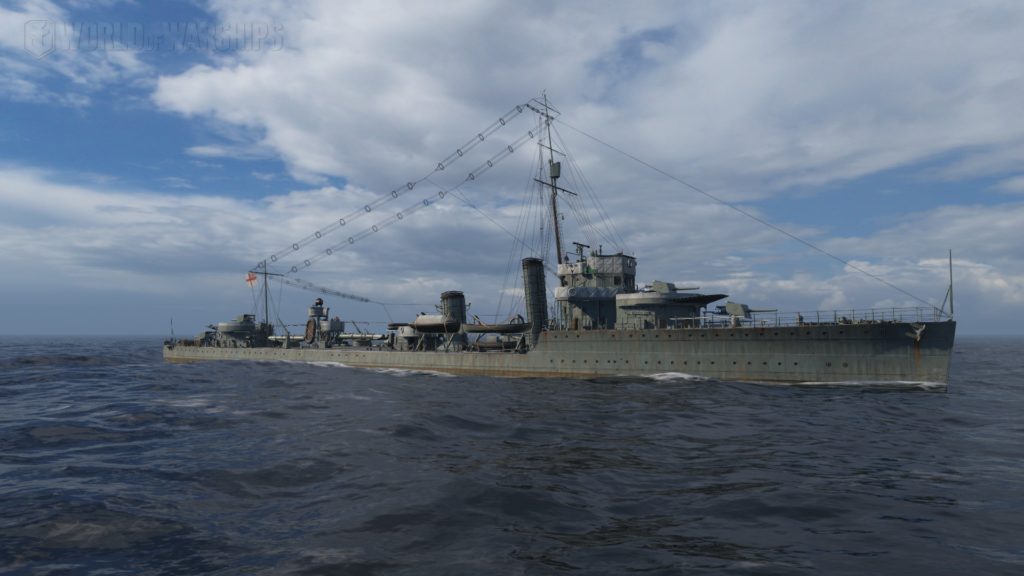
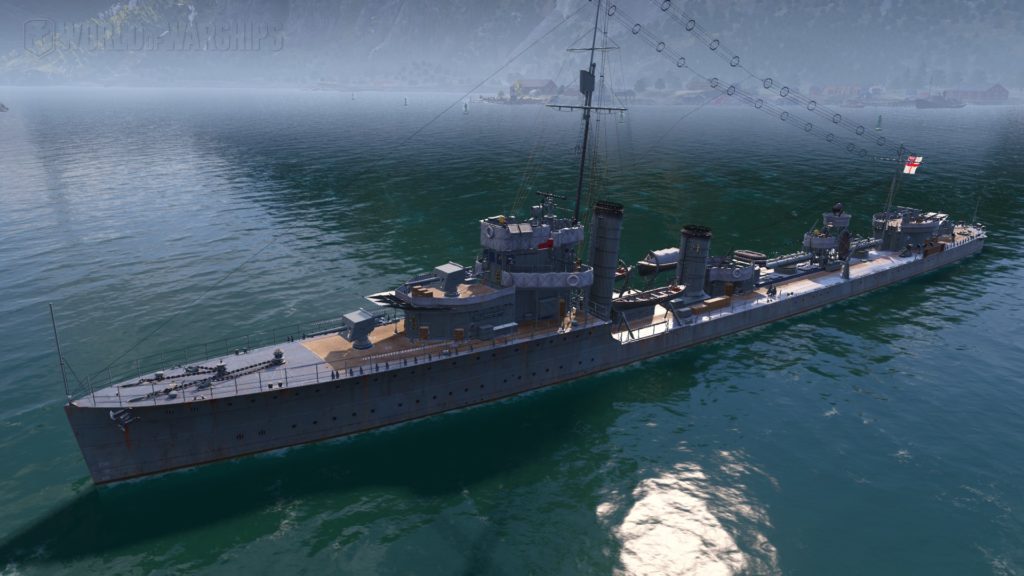
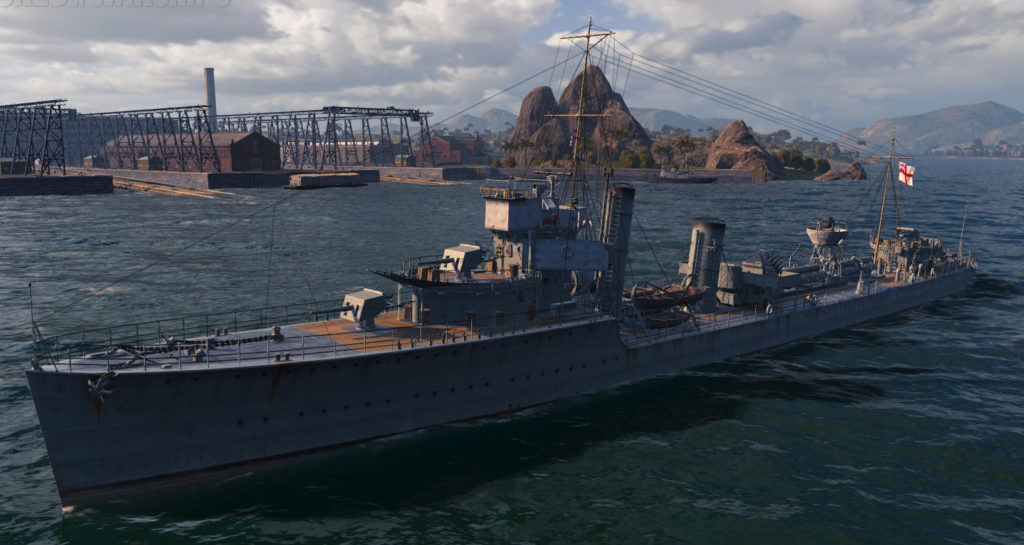
 Latest Facebook Entry -
Latest Facebook Entry -  X(Tweeter) Naval Encyclopedia's deck archive
X(Tweeter) Naval Encyclopedia's deck archive Instagram (@navalencyc)
Instagram (@navalencyc)





 French Navy
French Navy Royal Navy
Royal Navy Russian Navy
Russian Navy Armada Espanola
Armada Espanola Austrian Navy
Austrian Navy K.u.K. Kriegsmarine
K.u.K. Kriegsmarine Dansk Marine
Dansk Marine Nautiko Hellenon
Nautiko Hellenon Koninklije Marine 1870
Koninklije Marine 1870 Marinha do Brasil
Marinha do Brasil Osmanlı Donanması
Osmanlı Donanması Marina Do Peru
Marina Do Peru Marinha do Portugal
Marinha do Portugal Regia Marina 1870
Regia Marina 1870 Nihhon Kaigun 1870
Nihhon Kaigun 1870 Preußische Marine 1870
Preußische Marine 1870 Russkiy Flot 1870
Russkiy Flot 1870 Svenska marinen
Svenska marinen Søværnet
Søværnet Union Navy
Union Navy Confederate Navy
Confederate Navy Armada de Argentina
Armada de Argentina Imperial Chinese Navy
Imperial Chinese Navy Marinha do Portugal
Marinha do Portugal Mexico
Mexico Kaiserliche Marine
Kaiserliche Marine 1898 US Navy
1898 US Navy Sovietskiy Flot
Sovietskiy Flot Royal Canadian Navy
Royal Canadian Navy Royal Australian Navy
Royal Australian Navy RNZN Fleet
RNZN Fleet Chinese Navy 1937
Chinese Navy 1937 Kriegsmarine
Kriegsmarine Chilean Navy
Chilean Navy Danish Navy
Danish Navy Finnish Navy
Finnish Navy Hellenic Navy
Hellenic Navy Polish Navy
Polish Navy Romanian Navy
Romanian Navy Turkish Navy
Turkish Navy Royal Yugoslav Navy
Royal Yugoslav Navy Royal Thai Navy
Royal Thai Navy Minor Navies
Minor Navies Albania
Albania Austria
Austria Belgium
Belgium Columbia
Columbia Costa Rica
Costa Rica Cuba
Cuba Czechoslovakia
Czechoslovakia Dominican Republic
Dominican Republic Haiti
Haiti Hungary
Hungary Honduras
Honduras Estonia
Estonia Iceland
Iceland Eire
Eire Equador
Equador Iran
Iran Iraq
Iraq Latvia
Latvia Liberia
Liberia Lithuania
Lithuania Mandchukuo
Mandchukuo Morocco
Morocco Nicaragua
Nicaragua Persia
Persia San Salvador
San Salvador Sarawak
Sarawak Uruguay
Uruguay Venezuela
Venezuela Zanzibar
Zanzibar Warsaw Pact Navies
Warsaw Pact Navies Bulgaria
Bulgaria Hungary
Hungary

 Bundesmarine
Bundesmarine Dutch Navy
Dutch Navy Hellenic Navy
Hellenic Navy Marina Militare
Marina Militare Yugoslav Navy
Yugoslav Navy Chinese Navy
Chinese Navy Indian Navy
Indian Navy Indonesian Navy
Indonesian Navy JMSDF
JMSDF North Korean Navy
North Korean Navy Pakistani Navy
Pakistani Navy Philippines Navy
Philippines Navy ROKN
ROKN Rep. of Singapore Navy
Rep. of Singapore Navy Taiwanese Navy
Taiwanese Navy IDF Navy
IDF Navy Saudi Navy
Saudi Navy Royal New Zealand Navy
Royal New Zealand Navy Egyptian Navy
Egyptian Navy South African Navy
South African Navy






























 Ukrainian Navy
Ukrainian Navy dbodesign
dbodesign
Your site has been very useful to me. I am researching for a novel I am working on concerning a British WWI L class destroyer. Do you know where I might find deck plans? I do have a question. Was her power plant turbine/electric?
Regards,
Tom Cragg
Thanks Tom !
For British L-class destroyers, it was steam power only, but there was indeed an electrical generator for internal use. For plans, apart blueprints kept by local yards (i doubt they are in free access on the web), and private collections, you have the Greenwich coll. which contains many blueprints and yard models: https://www.rmg.co.uk/discover/museum-collections/ship-plans-collection
Cheers
David, aka dreadnaughtz